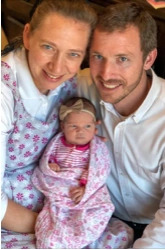#d. 21 March 2003
Explore tagged Tumblr posts
Text






This Week in Julie-History: Cover Girl 1955
Seventy years ago, Julie Andrews officially became an American "cover girl" for the first time with the publication of this lead story in the January 9, 1955 edition of the syndicated This Week newspaper magazine. Published just three months after her New York debut as Polly Brown in The Boy Friend, the magazine proclaimed Julie a new star who had "won Broadway's heart."
The colour cover photo was taken by renowned celebrity portraitist Zinn Arthur who recalled that "the January 9 issue of the magazine with [Julie] on the cover was her very first major USA exposure" (1990, p. 199). His shot captures an unusually relaxed and sultry Julie. Barely 19, she exudes the charm of a fresh-faced, American-styled teen, casually dressed in a slightly crumpled cotton shirt. Her tousled chestnut hair is swept up, and her smile blends youthful confidence with soft allure -- a perfect fifties girl next door.
The accompanying article by Charles D. Rice (1910–1971) extends the portrait of Julie as wholesome youth, incorporating many of the core themes that would come to define her star image in the years ahead. Described as "relentlessly winsome" and "utterly charming," Julie remains "a completely normal, even naive, young English actress" -- the kind of girl one would "like to bring home to Mother" (Rice, 1955, p. 23).
The piece also underscores Julie's connection to the past, highlighting her role in The Boy Friend, a nostalgic nod to 1920s musicals, and her "wide eyed" fascination with big city American culture. Even at this very early stage of her international career, Andrews was cast as a nostalgic feminine ideal, offering a comforting sense of continuity amid a rapidly changing modern world.
Sources:
Arthur, Z. (1990). Shooting superstars: Me, my camera and the show biz legends. Artique Press.
Assoc. Press. (1971). Charles D. Rice, magazine editor. New York Times. February 1, p. 35.
Assoc. Press. (2003). Zinn Arthur, 90, celebrity photographer. New York Times. March 21, p. C-11.
Rice, C.D. (1955). Can that be me? This Week: The Sunday Magazine, January 9, p. 23.
© 2025, Brett Farmer. All Rights Reserved.
17 notes
·
View notes
Text

Always under construction!! The arts used are mentioned in each post. The same goes for references that I'm only using for that post. Template // Art
ASTROLOGY
BOOKS
[1] TOMPKINS, Sue. Aspects in Astrology: A guide to understanding planetary relationships in the horoscope. One Park Street, Rochester, Vermont 057067: Destiny Books, 2002.
[2] RIBEIRO, Anna Maria da Costa. Sinastria: Estudo dos Relacionamentos Teoria e Prática. Rio de Janeiro, RJ: Hipocampo Editora e Distribuidora Ltda., 1989.
[3] ABDUL-KHALIQ, Ajani. Hayden’s Book of Synastry: A Complete Guide to Two-Chart Astrology, Composite Charts, and How to Interpret Them. 13 junho 2017.
[4] LEWIS, James R. The Astrology Book: The Encyclopedia of Heavenly Influences. Canton, MI: Visible Ink Press™, 2003.
[5] WOOLFOLK, Joanna Martine. The Only Astrology Book You’ll Ever Need. Lanham, Maryland: Taylor Trade Publishing, 2006.
[6]NICHOLAS, Chani. You Were Born for This: Astrology for Radical Self-Acceptance. New York, NY: HarperOne, 2020.
[7] GARGATHOLIL. Depth Astrology: An Astrological Handbook - Volume 1: Introduction. Smashwords Edition, 2014.
[8] GARGATHOLIL. Depth Astrology: An Astrological Handbook: Volume 2: Planets in Signs. Smashwords Edition, 2014.
[9] GARGATHOLIL. Depth Astrology: An Astrological Handbook: Volume 3: Planets in Houses. Smashwords Edition, 2014.
[10] GARGATHOLIL. Depth Astrology: An Astrological Handbook: Volume 4: Planets in Aspect. Smashwords Edition, 2014.
[11] REED, Theresa. Astrology for Real Life: A Workbook for Beginner. Newburyport, MA: Red Wheel/Weiser, LLC, 2019.
[12] LISBOA, Claudia. Os astros sempre nos acompanham (Edição revista e ampliada): Um manual de astrologia contemporânea. Rio de Janeiro: Best Seller, 2021.
[13] ORION, Rae. Astrology For Dummies, 2nd Edition. Hoboken, NJ; Indianapolis, Indiana: Wiley Publishing, Inc., 2007.
[14] DEVORE, Nicholas. Encyclopedia of Astrology. New York: The Philosophical Library, June 1947.
[28 ]MARCH, Marion D.; McEVERS, Joan. Curso Básico de Astrologia: VOLUME I - Princípios Fundamentais. Tradução de CARMEM YOUSSEF. São Paulo: EDITORA PENSAMENTO LTDA., 1999.
WEBSITES/BLOGS
[15] SERVANTOFTHEFATES. Disponível em: https://servantofthefates.tumblr.com/. Acesso em: 29 de mar. de 2023.
[16] LINHA ASTRAL - ASTROLOGIA: Seu site de Pesquisa Astrológica. Disponível em: https://linha-astral.com.br/. Acesso em: 29 de mar. de 2023.
[17] Astromatrix. Disponível em: https://astromatrix.org/. Acesso em: 29 de mar. de 2023.
[18] Astrolibrary. Disponível em: https://astrolibrary.org/ Acesso em: 29 de mar. de 2023.
[19] Cafe Astrology. Disponível em: https://cafeastrology.com/. Acesso em: 29 de mar. de 2023.
[20] Astrologia na era de aquário, astrologia e estudos astrológicos. Disponível em: http://astrologiaeradeaquario.blogspot.com/ . Acesso em: 29 de mar. de 2023.
[21] Astrology and Numerology Study. Disponível em:https://astrologystudy.blogspot.com/ . Acesso em: 29 de mar. de 2023.
[22] Astrologia Luz e Sombra. Disponível em: https://astrologialuzesombra.com.br/ . Acesso em: 29 de mar. de 2023.
[33] Astrolink. Disponível em: https://www.astrolink.com.br/artigo/a-historia-da-astrologia. Acesso em: 25 de maio de 2023.
YOUTUBE CHANNELS
[23] Marcelo Levi. Disponível em:https://www.youtube.com/@oimarcelolevi . Acesso em: 29 mar. 2023.
[24] Astronalia | Mariane Chagas. Disponível em:https://www.youtube.com/@astronalia . Acesso em: 29 mar. 2023.
[25] Encontros Astrológicos: Débora Mechica. Disponível em:https://www.youtube.com/@encontrosastrologicos. Acesso em: 29 mar. 2023.
[26] Lais Casttelo Academia Astrologia. Disponível em:https://www.youtube.com/@laiscasttelo . Acesso em: 29 mar. 2023.
[27] Marcia Fervienza Astróloga+. Disponível em:https://www.youtube.com/@MarciaFervienza . Acesso em: 29 mar. 2023.
MY COURSES
Astrologia Autêntica - finished
Astrologia Nível 1 - Iniciação by Astronalia - coursing
Gaia Astrologia
BLOCO FUNDAMENTAL (fase 1) - finished
HISTÓRIA DA ASTROLOGIA - finished
ASTROLOGIA E MITOLOGIA - finished
ASTRONOMIA BÁSICA - finished
BLOCO FUNDAMENTAL (fase 2) - coursing
TEMPLATES/PSDS
[29] minikyuns on deviantart
[30] Iapetite on deviantart
[31] wildfireresources on deviantart
[32] sorberts on tumblr
[34] sparklypalace on deviantart
[35] soudwronf on deviantart
[36] v6que on tumblr
73 notes
·
View notes
Text

Footnotes, 51-100
[50] Martin Crutsinger, “United States Cites China and Other Nations in Report on Unfair Trade Practices,” Associated Press, March 31, 2006.
[51] Dale Maharidge, “Rust and Rage in the Heartland,” Nation, September 20, 2004, www.thenation.com.
[52] Pam Belluck, “To Avoid Divorce, Move to Massachusetts,” New York Times, November 14, 2004, as quoted in Michelle Goldberg, Kingdom Coming, 67.
[53] By 2010, according to the Center on Budget and Policy Priorities, if the proposed federal cuts remain in place, elementary and secondary education funding will be cut by $11.5 billion, or 12 percent; 670,000 fewer women and children will receive assistance through the Women, Infants and Children Supplemental Nutrition Program; 120,000 fewer children will be served through Head Start; and 370,000 fewer low-income families, elderly people and people with disabilities will receive rental assistance with rental vouchers. See Sharon Parrott, Jim Horney, Isaac Shapiro, Ruth Carlitz, Bradley Hardy, and David Kamin, “Where Would the Cuts Be Made under the President’s Budget?: An Analysis of Reductions in Education, Human Services, Environment, and Community Development Programs,” Center on Budget and Policy Priorities, February 28, 2005, www.cbpp.org.
[54] Dale Maharidge, “Rust and Rage.”
[55] Arlie Hochschild, “The Chauffeur’s Dilemma,” American Prospect 16: 7 (July 2005), 53.
[56] Ibid.
[57] Dietrich Bonhoeffer, Life Together: The Classic Exploration of Faith in Community (New York: HarperCollins, 1954), 330.
[58] D. James Kennedy, Evangelism Explosion, 4th ed. (Wheaton, IL: Tyndale House, 1996), 59.
[59] Ibid.
[60] Ibid., 60.
[61] Ibid., 137.
[62] Ibid., 2.
[63] Ibid., 139.
[64] Ibid., 103.
[65] Ibid., 22.
[66] Margaret Thaler Singer, Cults in Our Midst: The Continuing Fight Against Their Hidden Menace (San Francisco: Jossey-Bass, 2003), 114.
[67] Robert Jay Lifton, cited in Denise Winn, The Manipulated Mind (Cambridge, MA: Malor Books, 2000), 21.
[68] William James, The Varieties of Religious Experience (Mineola, NY: Dover, 2002), 187.
[69] “Staff Biography: ‘Dr. James Kennedy,’” Center for Reclaiming America for Christ, www.reclaimamerica Us.aspx?pg=djk.
[70] “Dr. Kennedy’s Profile,” The Kennedy Commentary, www.kennedycommentary.org; Truths That Transform, Coral Ridge Ministries, www.truthsthattransform. org/ITT.asp?page=about; “About the Coral Ridge Hour,” The Coral Ridge Hour, www.coralridgehour.org page=crh.
[71] Terry Gross, “Closing the Gap Between Church and State,” Fresh Air from WHYY, May 18, 2005.
[72] Ibid.
[73] Bob Moser, “The Crusaders,” Rolling Stone, April 7, 2005, www.rollingstone.com =1140382586732&has-player=false.
[74] Ibid.
[75] Ashley Fantz, “Cross Purposes: The Rev. D. James Kennedy Teaches That Homosexuality Is a Sin. Richard Murphy Loves Him Anyway,” Broward–Palm Beach New Times, May 2, 2002.
[76] Worthy Creations, www.worthycreations.org.
[77] Rob Boston, “D. James Kennedy: Who Is He and What Does He Want?” Americans United for Separation of Church and State, www.au.org.
[78] Kennedy, Evangelism Explosion, 72.
[79] Ibid.
[80] Ibid., 73.
[81] Ibid., 84.
[82] Ibid., 42.
[83] Ibid.
[84] Paul Tillich, “You Are Accepted,” in The Shaking of the Foundations (New York: Charles Scribner’s Sons, 1948), 155.
[85] Kennedy, Evangelism Explosion, 48.
[86] D. James Kennedy and Jerry Newcombe, The Gates of Hell Shall Not Prevail (Nashville, TN: Thomas Nelson, 1996), 135.
[87] “Aggregated Grants to Coral Ridge Ministries, Coral Ridge Presbyterian Church and Evangelism Explosion” (grants cover January 1998 to February 2004), Media Transparency, www.mediatransparency.org.
[88] Klaus Theweleit, Male Fantasies (Minneapolis, MN: University of Minnesota Press, 1987), 1:218.
[89] Francis FitzGerald, “A Disciplined, Charging Army,” New Yorker, May 18, 1981, 53, quoted in Robert Smart, “The Passion of the Christ: Reflections on Mel’s Monstrous Messiah Movie and the Culture Wars,” Jump Cut 47 (Winter 2005), www.ejumpcut.org.
[90] Karen McCarthy Brown, “Fundamentalism and the Control of Women,” in Fundamentalism and Gender, ed. John Stratton Hawley (New York: Oxford University Press, 1994), 176.
[91] Ibid., 182–183.
[92] “Dobson’s Choice: Religious Right Leader Becomes Political Power Broker,” People for the American Way Foundation, February 24, 2005, www.pfaw.
[93] James Dobson, Dare to Discipline (New York: Bantam, 1977), 23.
[94] “Dobson’s Choice.”
[95] “Right Wing Organizations: Focus on the Family,” People for the American Way Foundation, www.pfaw#.
[96] “Dobson’s Choice.”
[97] James Dobson, “The Gender Gap,” Focus on the Family, www.family.org.
[98] Mark Edmundson, “Freud and the Fundamentalist Urge,” New York Times, April 30, 2006.
[99] Ibid.
[100] Susan Friend Harding, The Book of Jerry Falwell: Fundamentalist Language and Politics (Princeton, NJ: Princeton University Press, 2000), 176.
#christianity#fascism#right-wing#us politics#xtians#United States of America#christians#anarchism#anarchy#anarchist society#practical anarchy#practical anarchism#resistance#autonomy#revolution#communism#anti capitalist#anti capitalism#late stage capitalism#daily posts#libraries#leftism#social issues#anarchy works#anarchist library#survival#freedom
3 notes
·
View notes
Text
Fundie Families and Adjacents I Follow: Brown

Kody Winn Brown- January 17, 1969
Meri Caroline Barber- January 16, 1971
Janelle Schriever- May 6, 1969
Christine Ruth Allred- April 18, 1972
Robyn Alice Sullivan- October 9, 1978
Kody Brown is a mormon polygamist. He has had 4 wives in total but now only has one, Robyn. He has 15 children and 3 step-children.

Meri married Kody Brown on April 21, 1990. She was his first wife. They announced their separation in December 2022. Kody and Meri share 1 child.
Leon- July 29, 1995

Leon married Audrey Kriss (December 29, 1995) on October 29, 2022.

Janelle married Kody on January 20, 1993. She had been married before. She was Kody's second wife. They announced their separation in December 2022. Kody and Janelle share 6 children.
Logan Taylor- May 21, 1994
Madison Rose- November 3, 1995
Hunter Elias- February 9, 1997
Robert Garrison "Garrison"- April 10, 1998; d. March 5, 2024
Gabriel Winn- October 11, 2001
Savannah- December 7, 2004

Logan married Michelle Chapin Petty (November 10, 1992) on October 22, 2022.

Madison married Caleb Brush (January 8, 1987) on June 4, 2016. They share 4 children.
Axel James- May 20, 2017
Evangalynn Kodi- August 20, 2019
Josephine Lee- February 10, 2023
Baby- March 2025

Christine married Kody on March 25, 1994. She was his third wife. They announced their separation in November 2021. Kody and Christine share 6 children. She married David Woolley in October 2023.
Aspyn Kristine- March 14, 1995
Mykelti Ann- June 9, 1996
Paedon Rex- August 7, 1998
Gwendlyn Genielle- October 15, 2001
Ysabel Paige- June 13, 2003
Truely Grace- April 13, 2010

Aspyn married David Mitchell Thompson "Mitch" (1992) on Jun3 17, 2018.

Mykelti married Antonio Padron "Tony" (October 24, 1994) on December 17, 2016. They share 3 children.
Avalon Asa- April 5, 2021
Archer Banks- November 17, 2022
Ace McCord- November 17, 2022

Gwendlyn married Beatriz Queiroz (March 2000) on July 15, 2023.

Robyn was formerly married to David Jessop. They shared 3 children together. She later married Kody on May 22, 2010 as his fourth wife. Kody and Robyn share 2 children together.
David Preston "Dayton"- January 16, 2000
Aurora Alice- April 13, 2002
Breanna Rose- April 10, 2004
Solomon Kody- October 27, 2011
Ariella Mae- January 10, 2016
5 notes
·
View notes
Text
Instagram Intros (Pete Wentz’s Kids)


Greyson Peter Lewis Wentz (@greysonlewis)
DOB: March 11th 2003 Age: 21 years old Hometown: Chicago, Illinois Nicknames: Grey, Greys, Gigi S/O: Leanna Patton Kids: None Best Friend(s): Miles Stumph and Lincoln Merritt Aesthetic: Greyson was a wild card for both Pete and Amanda. He was born whilst they were still trying to understand what exactly they were. They knew that they loved each other, that they loved their son. They also knew that they couldn’t live without each other. Even though they had been dating for two years, one when they had found out, they weren’t too sure on the stability of their relationship. As a child, Greyson’s parents were on and off, though he had always had a good experience with their co-parenting. He thought he had the coolest dad in existence and begged his mom to let him go on tour with his dad and band members. He can vividly remember the first time he saw his dad perform. Pete was onstage slamming the ever living life out of his bass and in that moment Greyson knew what he wanted out of life. He wanted to be just like his father. When he was about 15 he had started a band and tried it out a few times with different people, but truly found his passion working with the young Miles Stumph. Miles always found Greyson as sort of a big brother and adored him in every way. Besides they grew up together watching their dad perform along side one another, why wouldn’t it be a good fit? And a good fit it was. They were touring two years later.


Mia Violet Blake Wentz (@mimipriv)
DOB: September 24th 2006 Age: 18 years old Hometown: Chicago, Illinois Nicknames: Mi, Mimi, Mini S/O: Graham Hill Kids: None Best Friend(s): Stella Stumph and Sasha Hensley Aesthetic: Mia Wentz’s nickname wasn’t mini for a reason. She was Mandy’s mini me through and through. Mia inherited both her mother’s lively spirit and beauty inside and out. It was funny to her mom, how her and her best friend Stella reminded her of her and her own best friend, Stella’s mother Anna. Mia was constantly lovin’ on her dad, just like Mandy. Always dancing in the car, and the shower, her room, and the grocery store, just like Mandy. Pete could’ve sworn that Mia was his wife only smaller and squeakier, it was something he found most endearing and he was proud of his baby for finding love in everything. She had this in-the-moment attitude about her from the beginning. It was an on-going joke between her parents that she was born early because she couldn’t wait to meet everyone and dance on something other than her mother’s bladder. When Mia was around five or six, she became the Fall Out Boy spokesperson. Everyone in the band claims that she’s the reason the hiatus ended and the new age of FOB began. Considering how young she had been when they broke up in the first place, she had a yearning to go on tour with her dad the way her older brother used to reminisce on with her. All of this to say, Mia was the reason we still have Fall Out Boy to this day.


David Alexander Cole Wentz (@davesoncolewentz)
DOB: August 7th 2010 Age: 14 years old Hometown: Chicago, Illinois Nicknames: Dave, Davey, D S/O: Elyse Waller Kids: None Best Friend(s): Zackery Waller and Isabella Strong Aesthetic: David hated his name. He hated it more than anything else in the entire world. His mother named him after his great grandfather, a man she loved as a little girl who had sadly passed away when she turned 21. Grandpa David was the only one in her family that accepted Pete, liked him and thought he was fantastic for his granddaughter. After her family had practically disowned her, she decided to live with him for a while once he got sick. Pete had made sure to ask for his approval to marry Amanda and the rest is history. Pete was actually the one to suggest naming their second son after the man. David despised him for it. He thought it sounded too old in his 2nd grade class of Mason’s, Jackson’s, and Ryan’s. He hated going to school because of the constant bullying he was facing. It wasn’t until he blew up on Pete one day that his father finally had had enough and lied down with his boy to have a chance at making the situation better. He had to explain why he was named after Grandpa David, then why his mother’s family disliked his father. He had to explain that he didn’t like his old man name either, but it suits him like David did him. Why should he want to have the same name as Jackson who sits beside him. Daveson would sound pretty silly huh Davey? It was a tough pill to swallow for a seven year old, but it worked, sort of. He had yelled a lot of hateful things at his dad, an outburst of all the anger and frustration built up from his peers who had hurt him. He cried to his dad after, the sense of guilt washing over him. Pete took him out of school the next day for a hangout with his boy and it became the norm every Tuesday until David got into high school and started skipping with his buddies. Pete still holds a special place in his heart for the two David’s, and the time he spent with them each.


Bruin Chester Bear Wentz
DOB: December 9th 2013 Age: 11 years old Hometown: Chicago, Illinois Nicknames: Bru, Boston, Ted, Teddy S/O: No One Kids: None Best Friend(s): Hattie Stumph and Ruby Trohman Aesthetic: Bruin was Pete's duplicate. They were the same person inside and out. He had his father’s curls and loud personality. He oftentimes had teacher’s phone his parents due to his active nature. He had a hard time with distractions and staying still for even a minute. He was diagnosed with ADHD when he was 8. At first he was embarrassed and didn’t like all the extra attention he received from staff at his school, but then he started doing really well in class, something he had difficulty with before. He loved his older brothers, always looking up to them for advice. David was the best with this, knowing what it’s like to be a younger brother himself. He taught him how to play the drums, something that could help with Bruin’s need to keep busy and stimulated. He actually got really good at this. His Uncle Andy even suggested him coming up on stage and playing with the band. Pete and Amanda were quite private with their family and children, trying their best to keep them away and safe from paparazzi and weird fans. So it’s safe to say that they were not too thrilled with the idea of their 9 year old being on stage in front of thousands of people with their cameras out. The rest of the band came to Bruin’s defence though saying it’s a good thing to show off what the kid has been dying to working on. Bruin had begged his parents all day all night until they finally agreed on one show one song and that’s it. Bruin freaked and called everyone he knew. It was truly a beautiful moment when the kid went on stage and jammed out with everyone, his dad was really proud that he could share this with his son. And you know damn straight David was in the curtain watching his little brother have the time of his life.


Romeo Edward Brookes Wentz
DOB: October 17th 2020 Age: 4 years old Hometown: Chicago, Illinois Nicknames: Ro, Rome, Romey S/O: No One Kids: None Best Friend(s): Charlotte Stumph and Lucky Otto Aesthetic: Romeo was by far the quietest out of the Wentz bunch. He rarely cried and when he did it came out more like a whimper. He was so quiet that he never woke his parents up during the night when he wailed and his mother had to put an alarm at night to check on him. Romey had a very good emotional radar. He was in touch with his emotions at a young age. Ro would communicate to his parents the same way you would see an adult do, and it shocked them how eerily well spoken their baby was. His first would was please when his father was feeding him, Pete of course taking too long talking to his wife, Romeo reached for the spoon waved in his face and said “Please” in the tiniest voice you could barely hear it. His parents heard and freaked out. He couldn’t even cry, just reach his tiny hand closer to his food. Ro didn’t like his father’s music, being a little too loud for his mini ears, and he wasn’t afraid to tell people. His Uncle Patrick invested in baby headphones for him at the next show. He was actually quite close to his Uncle Trick. They would just chat before shows about anything that came to Romey’s little brain. Things like how does the sun get energy and why are cats tinier than dogs. Things that Patrick didn’t know how to answer and so they would google it together. Bonding.


Evie Amara Inez Wentz
DOB: October 17th 2020 Age: 4 years old Hometown: Chicago, Illinois Nicknames: Eve, Evvy S/O: No One Kids: None Best Friend(s): Charlotte Stumph and Lola Roberts Aesthetic: Evie was the opposite of her twin brother Romeo. She was energetic and giggly, always running around, always trying to do something. She was much more ambitious too. While Romeo sat in his crib waiting for his mom’s alarm to go off, Evie was climbing out to remind her parents. She joined dance when she was 2 and has been dancing ever since. She makes sure that every single one of her Aunts, Uncles, Grandparents, and Siblings can attend her recital. She had loads of energy, and loved to sing along with her dad’s band and mom’s playlists. Evie loved playing mom with Mandy and PJ, inviting herself to dress and change her little brother, of course with the help of her parents. She would stand on a stool and feed him, watch as he played in his playpen, you name it, she helped. Eve was all around a good kid, knows her manners and is an early riser despite her parents praying she would just go back to bed. Pete was a big push over for his youngest daughter too. Oh you want a puppy? Here you go and toys and a new collar. The puppy’s name was Robbie if you were wondering. Still don’t know why she named him that.
#fob introductions#fob#pete wentz#pete wentz x oc#amanda wentz#amanda lynch#greyson wentz#mia wentz#david wentz#bruin wentz#romeo wentz#evie wentz#phillip wentz
2 notes
·
View notes
Text

Jonathan Moore (born April 21, 1969 - March 8, 2017) teacher, musician, entrepreneur, activist, and youth advocate, was born to Gwendolyn Jones and Jonny Moore in Seattle. He attended Morehouse College, where he formed the group Source of Labor with his brother Upendo “Negus 1” Tookas and DJ Kamikaze.
He started producing a series of community-based hip-hop shows and activities, the first of which, “African Echoes—A Hip-Hop Continuum,” premiered in 1992. Source of Labor played the Crocodile Café in Belltown, which brought Seattle’s ‘second generation’ of hip-hop downtown for the first time. He and his wife Erika “Kylea” White and Tookas—founded Jasiri Media Group, which Mickey Hess in the book Hip-Hop America: A Regional Guide.
He produced the all-age-friendly “Sure Shot Sundays” in 1999 at the Sit & Spin downtown to provide opportunities for young people to see, hear, and perform local hip-hop. It was there, that Ben “Macklemore” Haggerty made his live stage debut as a member of the group Elevated Elements.
When Seattle Mayor Paul Schell publicly blamed hip-hop for a 2000 shooting outside a Pioneer Square nightclub, he organized a peaceful rally at Westlake Park in response. Schell’s replacement, Greg Nickels, presented him with the Mayor’s Award for Excellence in Hip-Hop in 2003. He teamed with fellow Seattle icon Vitamin D to grow the local “Big Tunes” producer/ beat competition into a traveling national event broadcast on BET. He began co-hosting “Sunday Night Sound Session” with DJ Hyphen on KUBE 93 FM in 2005. A lunch with Sub Pop Records Executive VP Megan Jasper led to experimental Seattle hip-hop duo Shabazz Palaces, signing with the label in 2010, which led to the signing of up-and-coming local MC Porter Ray, and the release of his debut album Watercolor.
His depth of service and contributions place him among the most significant cultural figures in Seattle’s hip-hop history. He is survived by his wife, Caitlin Brower Moore, and two sons. #africanhistory365 #africanexcellence
2 notes
·
View notes
Text

IMAGES: USAF this time performs a "Mammoth Walk"
Fernando Valduga By Fernando Valduga 06/08/2023 - 18:02 in Military, War Zones
The U.S. Air Force's most recent "Elephant Walk" was so impressive that the U.S. officially called it the "Mammoth Walk", or Mammoth Walk.
On May 5, 57 subordinate aircraft of the 7ª U.S. Air Force from the bases of Osan and Kunsan, where the 51ª and 8ª Air Wings are stationed, respectively, were aligned at Osan Air Base, South Korea.

There were on the runway forty F-16C/D Fighting Falcons of the 35º, 36º and 80º Fighter Squadrons, twelve A-10C Thunderbolt II attack jets of the 25º Fighter Squadron, two U-2S Dragon Ladys spy planes of the 5º Reconnaissance Squadron and three C-12 Hurons transport turboprops from the 2ª
youtube
The F-16 and A-10 aircraft shown in the photos were armed with real missiles and bombs of various types, such as AIM-9 and AIM-120 for air combat, AGM-65 to attack ground targets and AGM-88 HARM for anti-radar, and GBU-38, GBU-54, GBU-31 and GBU-31(V)3 (Pilantogi

Some F-16s have also been equipped with the HARM system, which is rare in the Block 40 versions, but allows them to perform SEAD (anti-aircraft defense) missions such as the Block 50 versions, which are usually designed for this.

With the exercise, the United States of America impressively emphasized its commitment to the Indo-Pacific region. The presence of its air forces in South Korea should contribute to the stability of the region. Osan is the closest air base to communist North Korea.
Since World War II, the "Elephant Walk" has been a constant term in the U.S. Air Force. The Army Air Forces had a large number of bombers available in 1944, with which the U.S. regularly flew attacks with more than 1,000 aircraft. For this, the heavy planes rolled to take off in long rows one after the other. The image resembled the march of heavy elephants on their way to the next water point, the USAF statements described. The term remained and even entered the USAF regulations and since then, the Elephant Walk has been the official expression of an exercise with a maximum number of aircraft.

In elephant marches, the machines roll one after the other on the track. In their simple variant, they occur as a rolling exercise without takeoffs and subsequent landings. With the exercise, the air forces regularly check all aspects of a squadron's readiness to fulfill its war mission. "Correct" Elephant Walks end with the departure of all participating machines. Each aircraft capable of flying and ready for use and each crew must comply with the starting window of the war plan.

The recent "Mammoth Walk" at Osan Air Base was impressive, among other things, due to the wide variety of participating aircraft types - from twin-engine turboprop connecting planes to high-altitude reconnaissance jets. One of the largest Elephant Walks in number, on the other hand, is one that occurred in the 1980s, when 120 F-111 bomber fighters took off in less than an hour as part of Operation Desert Storm of 2003.
Tags: Military AviationElephant WalkUSAF - United States Air Force / U.S. Air ForceWar Zones - Korean peninsula
Fernando Valduga
Fernando Valduga
Aviation photographer and pilot since 1992, has participated in several events and air operations, such as Cruzex, AirVenture, Daytona Airshow and FIDAE. He has works published in specialized aviation magazines in Brazil and abroad. Uses Canon equipment during his photographic work around the world of aviation.
Related news
MILITARY
Kongsberg receives $65 million to upgrade Norwegian F-16 jets to Romania
09/06/2023 - 16:00
MILITARY
Turkish unmanned fighter Kizilelma completes flight tests and series production begins in 2024
06/09/2023 - 14:00
ARMAMENTOS
VIDEO: IRIS-T air-to-air missile is integrated into the South Korean KF-21 jet
06/09/2023 - 1:00 PM
The U.S. Air Force returned the first Boeing E-767 AWACS to the Japan Air Self-Defense Force after its modernization. (Photo: U.S. Air Force)
MILITARY
First E-767 AWACS delivered to JASDF after modernization
06/09/2023 - 12:00 PM
MILITARY
Germany refuses to deliver Taurus missiles to Ukraine
06/09/2023 - 11:00
AIR SHOWS
Egypt will host its first air show in 2024
06/09/2023 - 09:00
homeMain PageEditorialsINFORMATIONeventsCooperateSpecialitiesadvertiseabout
Cavok Brazil - Digital Tchê Web Creation
Commercial
Executive
Helicopters
HISTORY
Military
Brazilian Air Force
Space
Specialities
Cavok Brazil - Digital Tchê Web Creation
5 notes
·
View notes
Text
Events 4.7 (after 1940)
1940 – Booker T. Washington becomes the first African American to be depicted on a United States postage stamp. 1943 – The Holocaust in Ukraine: In Terebovlia, Germans order 1,100 Jews to undress and march through the city to the nearby village of Plebanivka, where they are shot and buried in ditches. 1943 – Ioannis Rallis becomes collaborationist Prime Minister of Greece during the Axis Occupation. 1943 – The National Football League makes helmets mandatory. 1945 – World War II: The Imperial Japanese Navy battleship Yamato, one of the two largest ever constructed, is sunk by United States Navy aircraft during Operation Ten-Go. 1946 – The Soviet Union annexes East Prussia as the Kaliningrad Oblast of the Russian Soviet Federative Socialist Republic. 1948 – The World Health Organization is established by the United Nations. 1954 – United States President Dwight D. Eisenhower gives his "domino theory" speech during a news conference. 1955 – Winston Churchill resigns as Prime Minister of the United Kingdom amid indications of failing health. 1956 – Francoist Spain agrees to surrender its protectorate in Morocco. 1964 – IBM announces the System/360. 1965 – Representatives of the National Congress of American Indians testify before members of the US Senate in Washington, D.C. against the termination of the Colville tribe. 1968 – Two-time Formula One British World Champion Jim Clark dies in an accident during a Formula Two race in Hockenheim. 1969 – The Internet's symbolic birth date: Publication of RFC 1. 1971 – Vietnam War: President Richard Nixon announces his decision to quicken the pace of Vietnamization. 1972 – Vietnam War: Communist forces overrun the South Vietnamese town of Loc Ninh. 1978 – Development of the neutron bomb is canceled by President Jimmy Carter. 1980 – During the Iran hostage crisis, the United States severs relations with Iran. 1982 – Iranian Foreign Affairs Minister Sadegh Ghotbzadeh is arrested. 1983 – During STS-6, astronauts Story Musgrave and Don Peterson perform the first Space Shuttle spacewalk. 1988 – Soviet Defense Minister Dmitry Yazov orders the Soviet withdrawal from Afghanistan. 1989 – Soviet submarine Komsomolets sinks in the Barents Sea off the coast of Norway, killing 42 sailors. 1990 – A fire breaks out on the passenger ferry Scandinavian Star, killing 159 people. 1990 – John Poindexter is convicted for his role in the Iran–Contra affair. In 1991 the convictions are reversed on appeal. 1994 – Rwandan genocide: Massacres of Tutsis begin in Kigali, Rwanda, and soldiers kill the civilian Prime Minister Agathe Uwilingiyimana. 1994 – Auburn Calloway attempts to destroy Federal Express Flight 705 in order to allow his family to benefit from his life insurance policy. 1995 – First Chechen War: Russian paramilitary troops begin a massacre of civilians in Samashki, Chechnya. 2001 – NASA launches the 2001 Mars Odyssey orbiter. 2003 – Iraq War: U.S. troops capture Baghdad; Saddam Hussein's Ba'athist regime falls two days later. 2011 – The Israel Defense Forces use their Iron Dome missile system to successfully intercept a BM-21 Grad launched from Gaza, marking the first short-range missile intercept ever. 2017 – U.S. President Donald Trump orders the 2017 Shayrat missile strike against Syria in retaliation for the Khan Shaykhun chemical attack. 2018 – Former Brazilian president, Luiz Inácio Lula da Silva, is arrested for corruption by determination of Judge Sérgio Moro, from the "Car-Wash Operation". Lula stayed imprisoned for 580 days, after being released by the Brazilian Supreme Court. 2018 – Syria launches the Douma chemical attack during the Eastern Ghouta offensive of the Syrian Civil War. 2020 – COVID-19 pandemic: China ends its lockdown in Wuhan. 2022 – Ketanji Brown Jackson is confirmed for the Supreme Court of the United States, becoming the first black female justice.
0 notes
Text
Loosing grammatical gender in Dutch: the result of bilingual acquisition and/or an act of identity?
Leonie Cornips, International Journal of Bilingualism (Vol 12, Issue 1-2) March-June 2008, Sage Publications Ltd. (UK). Document type: Report.
@ekingston apologies for the formatting, I just copy pasted everything lol
Abstract
In the Dutch sociolinguistic literature it is often noted that the overgeneralization of common gender, that is, the use of the definite article de where het is required, characterizes the Dutch variety(ies) of immigrants. Recent sociolinguistic research shows that this overgeneralization also occurs in the speech of subsequent generations born in the Netherlands who acquire Dutch as one of their first languages. The aim of this paper is to discuss whether the overuse of de can exclusively be ascribed to the effects of bilingual (2L1/child L2) acquisition. It is argued that although the overgeneralization of de constitutes a linguistic resource for every bilingual child acquirer (and even for monolingual acquirers), it only becomes meaningful in the indexing and reproducing of an (immigrant) "allochtone" identity versus the dominant (indigenous) "autochtone" one. It is used according to a set of language use norms defined by generations of that social group of speakers.
Key words
bilingual
acquisition
grammatical
gender
identity
1 Introduction
Grammatical gender in Dutch distinguishes between neuter and common nouns. This gender distinction is marked morphologically on the determiner if it has the features singular and definite: neuter nouns take het and non-neuter nouns take de. In contrast, no gender distinction is reflected on the indefinite, plural, and indefinite article in Dutch, as illustrated in Figure 1. (1)
In the Dutch sociolinguistic literature, it is often noted that overgeneralization of de characterizes the Dutch variety(ies) of immigrants and their native-born descendants (Aissati, Boumans, & Cornips, et al., 2005; Cornips, 2002, 2004; Cornips & de Rooij, 2003). The immigrants and their descendants use, in other words, de where het is required. According to Muysken (1984) and Snow, Van Eeden, and Muysken (1981), the Turkish and Moroccan immigrants entering the Netherlands in the 1960s frequently deleted the definite determiner and/or overgeneralized common gender. (2) More specifically, Muysken (1984) describes the spontaneous speech of a 21-year-old Moroccan who had been living in the Netherlands for three years. His proficiency was above average. However, his utterances showed that articles were often deleted or that they were erroneously used for example, de instead of het.
Recent sociolinguistic research shows also that this overgeneralization does not disappear; that is, the subsequent generations of the immigrants who are born in the Netherlands and acquire Dutch as one of the languages from birth onwards show this overgeneralization as well, as illustrated in (1) (cf. Cornips 2002; Cornips, 2004; Cornips & de Rooij, 2003): (1) a. zitten we in de laatste jaar are we in the final year [the-common year-NEUTER, Cengiz, Turkish descent, Utrecht, adolescent] b. de meest serieuze type the most serious type [the-common type-NEUTER, Abdelkhalek, Moroccan descent, Berber, Utrecht, adolescent] c. Hij had de juiste merk aan 'he was wearing the right brand' [the-common brand-NEUTER, Surinamese descent, Rotterdam, adolescent] d. interviewer: "deze vrouw snijdt de tomaat en deze vrouw ..." 'this woman cuts the tomato and this woman ...' Ayni: "snijdt de brood." cuts the bread [the-common bread-NEUTER, Ayni, Bolivian descent, Amsterdam, 6 yrs]
Thus, the bilingual (and monolingual) descendants of the former immigrants have a potential role in contact effects as observed in creole and other languages. Hence, it is not only the case that grammatical gender is disappearing in Dutch contact varieties in the Netherlands but it has already disappeared in contact situations outside the Netherlands. It took place in Dutch lexifier contact languages such as Negerhollands (Muysken, 2001, p. 165), Berbice Dutch, Afrikaans (Donaldson, 1993; Ponelis, 2005), Curacaos-Dutch (Joubert, 2005), Surinamese-Dutch (Cornips, 2005), and Indisch-Dutch (de Vries, 2005).
Interestingly, the overgeneralization of one gender takes place in immigrant communities with other languages too, such as the suburbs of Sweden where immigrants and their children learn Swedish as the target language (Kotsinas, 2001, p. 150). Also Quist (this volume) describes the extended use of the common gender where standard Danish nouns require neuter articles.
Taken together, grammatical gender constitutes a vulnerable domain for variation and change in language contact situations The aim of this paper is to discuss to what extent the overgeneralization of the definite determiner de is the result of processes of (early) child second language and/or bilingual acquisition (Cornips & Hulk, 2008; Hulk & Cornips, 2006b). In addition I will consider what other factors should be taken into consideration to explain this phenomenon.
The bilingual acquisition of grammatical gender in Dutch by Moroccan and Turkish children (Cornips et al. 2006)
2.1
At the end of the 1990s, a considerable amount of spontaneous speech of Moroccan, Turkish and Surinamese teenagers and adolescents in Utrecht was collected (approximately 8 hours. In Cornips (2002), the spontaneous speech of six male speakers who were mutual friends in the Utrecht neighborhood Lombok/Transvaal was examined. These speakers fell into three groups according to their language background: four Moroccan Arabic/Berber/Dutch, three Turkish Dutch bilinguals and one Surinamese (Hindi) Dutch. All speakers were in their early twenties. This group of friends is special in that they use Dutch to communicate with each other. Note that without Dutch, the young Moroccans are not able to communicate with each other since some speak Arabic and others Berber.
All participants, irrespective of the other languages which they speak, reveal a tendency to use the definite determiner de in cases where the definite determiner het is required, as illustrated in (2) (2) a. de geloof [Guray, Turkish descent] the-COMMON faith-NEUTER b. de hele gebouw [Hassan, Turkish descent] the-COMMON entire building NEUTER c. de laatste jaar [Hassan, Turkish descent] the-COMMON last year-NEUTER d. de boek [Badir, Moroccan descent] the-COMMON book-NEUTER e. de kanaal [Naraen Surinamese descent] the-COMMON channel-NEUTER
This tendency is much stronger than the other way round in which the definite article het is used for de: (3) a. bet nadruk [Guray, Turkish descent] the-NEUTER emphasis-COMMON b. het muziek [Badir, Moroccan descent] the-NEUTER music-COMMON
More evidence that neuter nouns are considered as common is the use of the deictic pronouns die and deze that combine with neuter nouns instead of the standard Dutch dat and dit which must precede neuter nouns: (4) a. die optreden [Naraen, Surinamese descent] this COMMON performance NEUTER b. deze gedeelte [Naraen, Surinamese descent] this COMMON part NEUTER c. die nummer [Hasan, Turkish descent] this COMMON number NEUTER d. die eten [Naraen, Surinamese descent] this COMMON food NEUTER
Strikingly, also diminutives--although they are always neuter in standard Dutch--may be treated as common nouns: (5) a. de filmpje [Badir, Moroccan descent] the COMMON movie NEUTER+DIM b. de vaste groepje [Youssef, Turkish descent] the COMMON steady group NEUTER+DIM
However, it is important to emphasize that it is only in the DP domain that these speakers differ from standard Dutch speakers. From a morphosyntactic perspective, the Moroccan and Turkish adolescents are standardlike with respect to other phenomena in Dutch such as negation, expletive constructions and word order (Cornips, 2002). Furthermore, in Cornips (2002) it is shown that the Moroccans and Turks in the group described above who overuse common gender most frequently, also use local substandard features most frequently. This is again an indication of their native speaker status, hence, proficiency in Dutch.
2.2
Experimental research
This section will describe the experimental research by Hulk and Cornips (2006) by focusing on one specific research question: Do children of Turkish and Moroccan descent raised in an ethnic minority community in The Netherlands reveal a nontarget-like acquisition of grammatical gender of the Dutch definite determiner, and if so, is this "fossilization-effect" also present in their monolingual peers?
In order to examine whether bilingual children reveal a fossilization effect, Cornips, Van der Hoek, and Verwer (2006) selected older children of Moroccan and Turkish descent, varying in age between 10;5 and 12;11 years old who all attend one primary school located in an ethnic minority neighborhood in Rotterdam. Furthermore, in order to determine the presence or absence of cross-linguistic influence, the authors carefully included both Moroccan-Arabic- and/or Berber- and Turkish-speaking bilingual children whose other language instantiates a gender distinction in its noun/determiner system or without gender altogether, respectively. Therefore, a group of 28 children was made up of (i) 12 bilingual children from Turkish descent, (ii) 12 bilingual children from Moroccan descent speaking Berber and/or Moroccan-Arabic and 4 Dutch monolinguals (of Dutch descent) as a control group. A language profile was obtained from these 24 Moroccan and Turkish children that provided not only information about competences in and preferences for languages spoken in the home environment but also about the language(s) spoken to and by parents, older and younger siblings, grandparents, and friends (see appendix). It is important to note that this language profile reveals that all children are born and raised in the Netherlands. Consequently, these children are exposed to Dutch from birth onwards although more research has to be done to find out the details about the quantity and quality of the input to which they were exposed. Strikingly, Dutch is not spoken by the parents in only three Moroccan (out of 12) and five Turkish families (out of 12). Although those parents don't speak Dutch at all in the home domain, these eight children report speaking Dutch with their siblings. An interview fragment with Nabil of Moroccan descent, selected in other research, nicely illustrates this:
Nabil 10;5 Moroccan descent
Interviewer: Wat spreken je ouders?
Nabil: Marokkaans.
Nabil: Maar ik spreek altijd met mijn zus Nederlands.
Interviewer: What language do your parents use?
Nabil: Moroccan.
Nabil: But I always speak Dutch to my sister
Moreover, it is striking that the majority of the 24 children prefer to exclusively speak Dutch with their friends and consider Dutch to be their best language. Thus, even if the parents do not speak Dutch to the child, this does not mean that the home-situation is predominantly monolingual Turkish or Moroccan/Arabic or Berber. Thus the role of the siblings seems to be crucial in the exposure of Dutch from birth onwards (Hazen, 2002, Milroy & Li Wei, 1995). According to Hazen (2002, p. 516) the differences between older and younger siblings may point to the fluid and complex nature of language variation in migrant families. The children who most closely follow the language patterns of their parents are those in families more recently arrived. As the social integration of the family changes, the effects on older and younger siblings will differ. Whereas an older sibling may be more connected to the family when the family arrived recently, a younger sibling a few years later may have more opportunity for peer group interaction (Hazen, 2002, p.516)
2.3
Definite determiner: Fossilization and crosslinguistic influence?
2.3.1
The bilingual children
The results regarding the (non)target use of the definite determiners de and het are presented in Table 1 below. It reveals that both the monolingual and bilingual children (i) produce a higher score of the common determiner de than the neuter determiner het and (ii) overgeneralize de, namely 18.7% and 48.96% respectively. It is important to point out that experimental and spontaneous data have shown that monolingual acquisition of neuter gender of the Dutch definite determiner is a long-lasting process in the sense that the monolingual ethnic Dutch children do not acquire a target grammar until relatively late compared with other target language properties, namely age six. (cf. references in Hulk & Cornips, 2006a,b). Overall, the bilingual children reveal lower percentages compared to the monolingual children, especially with respect to the target-like use of het (42.01% vs. 68.8%, respectively). Note that this target-like use is below chance level. (3)
Since the bilingual children in this experiment are already relatively old, that is, between 10;5 and 12;11 years, it is likely that their grammar has "fossilized" with respect to the acquisition of the neuter definite determiner (cf. Hulk & Cornips, 2006a,b). However, only if we were to follow these children longitudinally would we be able to conclude that the results in Table 1 display their ultimate attainment.
Furthermore, the results in Table 2 reveal that having a noun/determiner system with a gender distinction in the other language (Moroccan-Arabic and/or Berber) or not (Turkish) is not crucial. The Moroccan children do not differ significantly from the Turkish children or vice versa:
2.3.2
The monolingual children
Interestingly, Table 1 presented above also shows that the monolingual children do not produce a 100% correct score for both the definite determiners de (83.3%) and het (68.8%) at an age between 10;5 and 12;11 years old. It seems that the monolingual children in a primary school located in an ethnic minority community are sensitive to peer groups effects with bilingual acquirers of Dutch in the sense that their standard-like use of het is rather low. More evidence that monolingual children are sensitive to input from their bilingual peers comes from a study by Brouwer, Cornips, & Hulk (2008). They conducted an experiment to "tap the knowledge" of monolingual children (and bilinguals) in two age groups (6-8 and 11-13 year-olds) about grammatical gender in Dutch. It appears that the location of the primary school in a monolingual or multilingual neighborhood is an important factor in determining the effects of the social stratification of the target-like awareness of grammatical gender in Dutch. Brouwer et al. distinguished two sociolinguistic contexts for the monolinguals, namely, monolinguals in a 100% and in a 75% monolingual school. It appears that the two monolingual groups differ significantly with respect to the awareness of grammatical gender in Dutch, as presented in Table 3: (4)
Thus, the acquisition of grammatical gender, in addition to internal linguistic factors, is (Cornips & Hulk, 2008) extremely sensitive to input so we may assume that it is sensitive to peer-group effects as well.
Until now, the experimental results show that the Moroccan and Turkish children do not differ significantly. So, the overgeneralization of de is not restricted to one group with a specific national and/or cultural, linguistic origin, that is, only the Turkish or Moroccan children. Subsequently the concept of ethnolect or ethnicity as an independent variable assuming a fixed link between an observed linguistic variant and ethnic identity is extremely doubtful (Cornips & de Rooij, 2004; de Rooij, 2005).
In order to find out if, and to what extent, the overgeneralization of de is restricted to children of Moroccan and Turkish descent, let us consider a completely different group of child second or child bilingual acquirers, namely English-Dutch bilingual children from expatriate families (cf. Unsworth 2006).
3 Bilingual children from a "one parent-one language" setting
The children of Turkish and Moroccan descent who participated in the experiments described above differ considerably from those who have generally been examined in "one parent--one language" research. The bilingual children from ethnic minority communities (i) belong to lower-class families, (ii) have been raised bilingually in a bilingual, that is, ethnic minority community, (iii) have one or both parents who are not native speakers of Dutch, and (iv) have been raised bilingually within a family in which language choice "rules" do not reflect a "one parent, one language" setting at all. Instead, according to Auer (1995, p, 115), in many if not in all "new" bilingual communities that have come into being in Europe as a consequence of work-related migration, language choice is often indecisive.
However, in "one parent--one language" research the bilingual children such as the English-Dutch children we will discuss below (i) belong to middle-class families, (ii) have been raised bilingually from birth in an otherwise monolingual community, and (iii) have parents who speak their respective varieties as native (L1) speakers (Meisel, 1989). Clearly, with respect to linguistic behavior, these families function as small, isolated groups in which the language choice rules are not at all reflected in the surrounding community.
In order to find out whether overgeneralization of de is restricted to bilingual child acquirers descending from immigrant communities, I will present the results of a study of bilingual English-Dutch children by Unsworth (2006). Unsworth (2006) examined 58 bilingual English-Dutch children who all attended international schools in The Netherlands at the time of testing, and some of them had previously attended Dutch pre-/primary schools. The children were predominantly from middle class families who had moved to The Netherlands for professional reasons. Their age at the time of testing ranged from 5;3 to 17;4 (mean 10;5, SD 3;8), their age of first exposure to Dutch from birth to 7;3 (mean 4;10; SD 1;9) and their length of exposure from 0;11 tot 15;2 (mean 5;6; SD 3;8). Unsworth raises two research questions: (i) do English-speaking bilingual children also overgeneralize the definite determiner de and (ii) if so, do they fossilize in this stage? In order to find out, she collected semispontaneous data using a picture description task. The results are presented in Table 4:
Table 4 displays that the English-Dutch children overgeneralize de for neuter nouns to a high extent, namely 74.6%. (5) Thus, the question whether bilingual children from a different type of bilingual population also show loss of grammatical gender of the definite determiner can only be answered affirmatively. What is important to point out is that Unsworth (2006) convincingly discusses that the use of target-like het with neuter nouns increases significantly with (i) quantity of exposure (length) to Dutch, (ii) with the quality of exposure (intensity) to Dutch and with (iii) proficiency in Dutch but in all cases the different groups are still only at chance level, that is, the target-like score of het varies between 34.3% and 51%.
Thus, both Moroccan/Turkish immigrant and English expatriate children fail to produce het with neuter nouns in Dutch in a target-like way, even when they are rather old. From this, we have to conclude that overgeneralization of de is not simply due to crosslinguistic influence (or so-called interference, substrate effects) from the other language having a gender/noun distinction in its grammar (Moroccan-Arabic/Berber) or without this distinction (Turkish, English). Importantly, it appears that the overgeneralization of de is a resource for every bilingual child acquirer in Dutch and even for monolingual children acquiring Dutch in a multilingual context.
4 Ethnolect: Process of "ethnic" identification and stereotyping
Until now, subjects are categorized as "Moroccan," "Turkish," and "English" on the basis of their other individual language(s). However, these categories do not imply that the individuals within these categories are homogenous with respect to their experiences as immigrants, newcomers to Dutch society, gender, education, SES and neighborhoods where they live, religious and cultural associations, and so forth (see also Cutler, this volume; Fought, 2006). There is no necessity that the outsiders' categorization as "Moroccan," for instance, signals group membership from the insiders' view. For example, Koole and Hanson (2002) discuss a classroom discourse in the Netherlands in which a primary school teacher uses the national identity category 'Moroccan' to identify pupils inside and outside the classroom and attributes meanings to this category in terms of category-bound activities such as "Moroccan women wear headscarves for religious purposes." However, although the teacher uses "Moroccan," many children belonging to this category from an outsiders' view do not adopt Moroccan to refer to themselves. Social groups such as ethnic ones need not be defined beforehand. The concept of ethnolect focusing on migrant communities categorized on the grounds of region of origin, ethnicity, and religion might essentialize groups and ignore their overlapping networks. Hence, as is the case in the Dutch context, young native-born descendents of immigrants meet each other in very diverse urban contexts--as do other newcomers--creating a linguistic diversity or using linguistic variants which are not necessarily "theirs" through family heritage or they may use variants which "are not generally thought to belong to them" for purposes of creating alternative solidarities (Rampton, 1995). As Fought (2006, p. 38) discusses, we cannot say that members of an ethnic group will construct an ethnic identity in the same linguistic way all the time. There are different types of contexts for the construction of ethnicity through language, including at the very least: (a) the situational context which can vary from one conversation to the next or even within a single conversation, (b) the broader context of an individual's life history, and (c) the social context of how the community, or a segment of the community, views ethnicity at a particular point in time. Essential in the concept of ethnolect is the important role of both self-identification and the perceptions and attitudes of others in the construction of ethnic identity.
The meaning of ethnicity and/or ethnic groups (ethnic variety) in the Netherlands developed in the context of a theory that focused on immigrants of Moroccan and Turkish descent on a former chain-immigration setting. Moroccans and Turks are treated as a single entity by the dominant ideology (cf. Fought, 2006, p. 15). What Turks and Moroccans in The Netherlands have in common are their size, cultural backgrounds, socioeconomic status, and the same historical demographic patterns of immigration. Turkish and Moroccan men who immigrated to the Netherlands in the sixties came to work as unskilled laborers in the industrial sector. The majority of these laborers originated from the countryside where the educational facilities were very poor. Over 90% of the Moroccan and about 55% of the Turkish inhabitants in The Netherlands between 50 and 64 years old did not finish primary education (Jongenburger & Aarssen, 2001). According to Dabene and Moore (1995, p.21), the early migrants encouraged family and village members to travel to the host county and join them in work. Newly arriving migrants often had friends and acquaintances in the closed group of people they already knew, directly or via other people, in their place of origin. Subsequently, specific migratory chains rapidly emerged, leading new arrivals to settle in specific city neighborhoods in the host country, and voluntary clustering and social encapsulation are strengthened. This explains the emergence of ethnic enclaves in cities with large migrant populations. This clustering, reinforced by the arrival of women and children in later years, allows groups to function as a micro-society or an extended family.
In the Dutch context, the arrival of work-related immigrants resulted in the construction of an "us" versus "them" opposition, to be more specific, an "autochtone" versus an "allochtone" identity, respectively. (6)
Although the overgeneralization of the definite determiner de constitutes a linguistic resource for every bilingual child acquirer (and even for monolingual acquirers), it only becomes meaningful in a process of ethnic identification (de Rooij, 2005), that is to say, it is an element in the indexing and reproducing of an (immigrant) "allochtone" identity versus the dominant "autochtone" one. There are several pieces of evidence.
First, as a group and even as individuals, the English-Dutch children from expatriate families are highly invisible in Dutch society. They are not openly commented upon and there is not something like an English/American community or neighborhoods in The Netherlands. Second, Unsworth's study shows that the English-Dutch children show progress in the target-like use of het with length (and extent) of exposure to Dutch and with proficiency. However, the children, teenagers, and adolescents from Turkish and Moroccan (and Surinamese) descent are exposed to Dutch from birth onwards and their proficiency in Dutch is target-like (§ 2.1). Third, the young people from Moroccan and Turkish descent are highly visible in Dutch society: many of them live in ethnic minority communities in cities and they are frequently commented upon by members of Dutch society and politicians. Finally, the overgeneralization of de has the status of a stereotype (Labov, 1994). The use of this variant is sufficient to stereotype young people as "allochtone" (immigrant) or non-Western originally. This single feature of language use suffices to identify someone's membership of a given group (Tabouret-Keller, 1997, p. 317).
Fragment 1:
Jeroen: egen wie ben je aan 't praten, tegen wie ben je aan 't praten?
Martje: egen die cling [ ... ]
Jeroen: ho are you talking to, who are you talking to?
Martje: to that thing [ ... ]
meta: die ding [that.sub.COMMON] [thing.sub.NEUTER]
Fragment 2:
Jeroen: Wij even wat inspreken op deze bandje?
Jeroen: We say something on this tape?
meta: deze bandje [this.sub.COMMON] tape-[DIM.sub.NEUTER]
Cornips and de Rooij (2004) discussed young Surinamese who imitate or stereotype Antillians in Rotterdam by means of nontarget like use of the common demonstrative pronoun. They use common die instead of neuter dat 'that'. Ronald, Vincent, and Gerard in the fragment below are of Surinamese descent and belong to a core-group of four males who are mutual friends (cf. Cornips, 2004).
Interviewer: kunjij ook Antilliaans.
Ronald: dumpen+ ...
Interviewer: hah?
Gerard: gewoon straattaal Antilliaans xx.
Interviewer: xx eenvoorbeeld?
Gerard: ja dat, ik schop die ding terug.
meta: they are imitating young Antillian, he laughs
Ronald: ik heb gezien dat je xx.
meta: they are imitating young Antillians
Vincent: ik rende voor die bus, maar die bus rende weg.
meta: they are imitating young Antillians
Ronald: ik heb gezien dat je die jongen hebt geschiet.
Vincent: ik schiet je met die mes.
meta: they are imitating young Antillians
Ronald: jongen met die broek met die korte mouwen.
meta: they are imitating young Antillians
Interviewer: maar dat is geen Antilliaans?
meta: she laughs
Vincent: zo praten ze.
Interviewer: zo praten ze.
Interviewer: are you able (to speak) Antillian [Papiamentu]
Ronald: throw away
Interviewer: hat?
Interviewer: n example?
Gerard: es, that, I kick that thing back
meta: hey are imitating young Antillians, he laughs
%morph die ding [that.sub.COMMON] [thing.sub.NEUTER]
Ronald: I saw that you xxxx
meta: they are imitating young Antillians
Vincent: I tried to catch the bus but the bus ran away
meta: they are imitating young Antillians
Ronald: I saw that you shot that boy
I shoot you with that knife
meta: they are imitating young Antillians
%morph die mes [that.sub.COMMON] [knife.sub.NEUTER]
Ronald: boy with those trousers and short sleeves
meta: they are imitating young Antillians
Interviewer: but that's no Antillian [Papiamentu]?
meta: they laugh
Vincent: that's the way they talk
Interviewer: that's the way they talk
Furthermore, an interview with Brian of Surinamese descent reveals that by means of the overgeneralization of common de, he creates an opposition between Rotterdam and Amsterdam and between Surinamese and Antillians young people (Cornips, de Rooij, & Reizevoort, 2006):
Fragment 4:
[Brian, 33 years, Surinamese descent, Amsterdam, Steve Bikoplein, date 05-11-2004]
Interviewer: Zeg je ook, of zeg jij ... zeggen ze ook: "wil je even wat inspreken op deze bandje"?
(...)
Interviewer Maar ook dingen als die boek en zo? Dat is vaak toch, die boek?
Brian: Maar aaa ... alles is bijna die.
(...)
Brian: (...) eh ... die komt meestal voor in Rotterdam.
Interviewer: Ja?
Brian: ... of je nou blank bent of niet, alles is daar is die. Alles, toch, bij alles gewoon die. En Amsterdam ... Amsterdammers hebben dat gewoon minder. Maar Surinamers ... nee, die is echt een probleem bij de Antilliaanse mensen. Bij hun is alles die.
Interviewer Ja.
Brian Die meisje ... die ... bij Surinamers dat valt nog mee.
Interviewer: Do you say also, do you say also' Do you want to say something on this tape"?
%morph: deze bandje [this.sub.common] [tape.sub.DIM+neuter]
(...)
Interviewer and things as this book and so? It is often that book right?
%morph: die boek [that.sub.common] [book.sub.neuter]
Brian: But ... everything is almost [die.sub.common]
(...)
Brian: die often occurs in Rotterdam
%morph: die [that.sub.common]
Interviewer: yes?
Brian: whether you are white or not, everything there is die. Everything, everything just die. And Amsterdam, Amsterdam people have that less. But Surinamese people ... no die is really a problem for Antillian people. Everything is die for them.
Interviewer: yes
Brian: that girl.... that ... it's not so common among Surinamese people
%morph: that common girl neuter
Importantly, Nortier and Dorleijn (this volume) point out that teenagers and adolescents Moroccan descent are developing both linguistic norms and norms of stylistic appropriateness, and overgeneralization of common gender is crucially involved, as is illustrated by the following quotation from a conversation with an informant (S) from Rotterdam (J and M are the interviewers):
S: Dat is het slechte Nederlands
J: En heeft dat ook een naam?
S: Ja, niet echt, maar 't is in principe dan eh lidwoorden die gebruik je dan expres verkeerd
M: Ja ja die gebruik je dan expres verkeerd, net als
S: Ja, dus
J: Die meisje
S: Die huis zeg ik dan. Terwijl ik weet ik bedoel ik weet heus wel dat het dat huis is maar 't staat zo dom als ik dat op straat zeg, als ik zeg
M: Ja
S: Als ik zeg dat huis
M: Jaja
S: 't Is gewoon die huis. Maar als ik met jullie spreek dan wordt 't gewoon dat huis.
S: That is the bad kind of Dutch.
J: Does it have a name?
S: No, not really, but in principle you uhmm ... just use the articles Deliberately in the wrong way.
M: Right! So you use them in the wrong way deliberately? Just like
S:--Yes, like
J: Die meisje ('that girl'--dat meisje in standard Dutch)
S: I would say: Die huis ('that house--dat huis in standard Dutch). At the same time I know, I mean, I am very well aware of the fact that it should actually be het huis, but it would make a dumb impression if I would say....
M: Yes
S: If I would say dat huis out on the street
M: Yes, yes.
S: It is just die huis. But when I speak with you two (the interviewers, both Dutch and middle-aged JN / MD) it is just dat huis.
"The speaker in the quotation explicitly says that you have to make errors, deviations from the standard norm, in order to be recognized as someone who is hanging out with friends" (cf. Nortier & Dorleijn, this volume). This quote suggests that the "optional" nature that goes with a minority ethnic identity affects its linguistic expression. For the older generation, it was a learner characteristic; the younger generations born in The Netherlands are able to downplay or to put it forward (Fought, 2006, p. 93).
To conclude, the overgeneralization of de cannot be ascribed to bilingual acquisition effects alone, but is governed by linguistic norms of the members of a group (Le Page & Tabouret-Keller, 1985).
5 Conclusion
The aim of this paper was to discuss whether the overuse of the singular definite determiner de instead of het, could exclusively be ascribed to the effects of bilingual (2L1/child L2) acquisition. It is argued that although the overgeneralization of de constitutes a linguistic resource for every bilingual child acquirer (and even monolingual acquirers), it only becomes meaningful in the indexing and reproducing of an (immigrant) "allochtone" identity versus the dominant "autochtone" one. Loosing grammatical gender plays a crucial role in the process of stereotyping "the other." On the one hand, from an outsiders' perspective, it is a characteristic ascribed to young people who are descendants from immigrant groups (excluding the English-Dutch speaking group). On the other hand, it indexes group membership and in-group speech and may serve as an ethnic marker or stereotype. It is this indexing group membership that explains why the older Moroccan and Turkish children fossilize in a nontarget-like stage although they have been exposed to Dutch from birth onwards. Their "incomplete" learning of the Dutch determiner system is incorporated into their language and "incomplete" learning becomes meaningful, not a mistake, and is used according to a set of language use norms defined by generations of that social groups of speakers. Thus, they acquire a different variety of Dutch successfully, that is to say, an insiders' variety of Dutch. Appendix Language profiles--reported behaviour by the children: Moroccan and Turkish bilingual children in a multilingual setting (NL = The Netherlands; M = Moroccan Arabic/Berber; T = Turkish) country country country of birth of birth name age of birth mother father Ihsan 11;0 NL NL M Hicham 12;8 NL M M Malika 12;7 NL M M Hakim 12;10 ? M M Loubna 11;5 ? M M Mohamed 12;5 NL M M Ali 11;6 NL M M Jihad 12;10 NL M M Kaoutar 12;5 NL M M Latifa 12;8 NL M M Yousra 11;10 NL M M Soufiane 12;1 NL M M Emre 11;0 NL T T Merve 12;11 NL T T Niyazi 12;2 NL T T Serdal 12;5 NL T T Tolga 12;9 NL T T Elif S 11;8 NL T T Faruk 11;8 NL T T Melis 12;5 NL T T Elif A 11;9 ? T T Ramazan 12;9 ? T T Berna 11;2 ? T T Cem 10;9 NL NL T Cemre 11;0 NL T T home mother father grandfather name language speaks speaks speaks Ihsan M M M M Hicham M+D M M M Malika M+D M M M Hakim M+D M M+D Loubna M M M+D M Mohamed M+D M D+M M Ali M+D M+D M+D M+D Jihad M+D M+D M M Kaoutar M+D M+D M+D Latifa M+D M+D M M+D Yousra M+D M+D M M Soufiane M+D D D M Emre T+D T T T Merve T T T T+D Niyazi T T T T Serdal T+D T T T Tolga T+D T T T Elif S T+D T+D T T Faruk T+D T+D T T Melis T+D T+D T+D T+D Elif A T+D T+D T+D Ramazan T+D T D T Berna T+D D T T Cem T+D D T T Cemre T+D D T T grandmother older younger name speaks siblings siblings Ihsan M M+D Hicham M M+D D Malika M D Hakim M M+D D Loubna M M+D Mohamed M M+D M+D Ali M+D M+D M+D Jihad M M+D M+D Kaoutar M D D Latifa M Yousra M M+D M+D Soufiane M D D Emre T T+D Merve T+D Niyazi T T+D Serdal T T+D T+D Tolga T T+D Elif S T T+D Faruk T D D Melis T+D T+D Elif A T+D Ramazan T D D Berna T D Cem D+T D+T Cemre T D lang. most with best favourite name friends language language Ihsan M+D M+D D Hicham M+D D M Malika D D D Hakim M+D M+D M+D Loubna D M+D Mohamed M+D M+D M+D Ali D Jihad M+D D M Kaoutar D D D Latifa D D M+D Yousra D M D Soufiane D D M Emre T+D T+D T+D Merve T T+D T Niyazi T+D T T+D Serdal T+D D D Tolga T+D T+D D Elif S T+D D T+D Faruk T+D D T Melis T+D T+D T+D Elif A T+D T+D T+D Ramazan D D D Berna T+D D T Cem D+T D T Cemre D T+D T+D
Acknowledgment
I would like to thank two anonymous reviewers for their valuable comments.
References
AISSATI, A. El-, BOUMANS, L. & CORNIPS, L., DORLEIJN, M., & NORTIER, J., (2005). Turks- en Marokkaans Nederlands [Turkish and Moroccan Dutch]. In N. van der Sijs, (Ed.), Wereldnederlands. Oude en jonge varieteiten van het Nederlands (pp. 149-183). The Hague: SDU.
AUER, P. (1995). The pragmatics of code-switching: A sequential approach. In L. Milroy, & P. Muysken (Eds.), One speaker, two languages: Cross-disciplinary perspectives on code-switching (pp. 115-135). Cambridge: Cambridge University Press.
BROUWER, S., CORNIPS, L., & HULK., A. (2008). Misrepresentation of Dutch target-like neuter gender in older bilingual children? In B. Haznedar & E. Gavruseva (Eds.), Current trends in child second language acquisition: A generative perspective. Amsterdam: John Benjamins.
CORNIPS, L. (2002). Ethnisch Nederlands [Ethnic Dutch]. In H. Bennis, G. Extra, P. Muysken, & J. Nortier (Eds.), Een Buurt in Beweging. Talen en Culturen in het Utrechtse Lombok en Transvaal (pp.285-302). Amsterdam: Aksant.
CORNIPS, L. (2004). Straattaal: Sociale betekenis en morfo-syntactische verschijnselen [Streetlanguage and morphosyntactic phenomena]. In J. de Caluwe, G. de Schutter, M. Devos, & J. Van Keymeulen (Eds.), Taeldeman, man van de taal, schatbewaarder van de taal (pp. 175-188). Gent: Academia Press.
CORNIPS, L. (2005). Het Surinaams-Nederlands in Nederland [Surinamese-Dutch]. In N. van der Sijs (Ed.), Wereldnederlands. Oude enjonge varieteiten van bet Nederlands (pp. 131-147). The Hague: SDU.
CORNIPS, L., & HULK., A. (2006). External and internal factors in bilingual and bidialectal language development: Grammatical gender of the Dutch definite determiner. In C. Lefebvre, L. White, & C. Jourdan (Eds.), L2 acquisition and creole genesis. Dialogues (pp. 355-378). Amsterdam / Philadelphia: John Benjamins.
CORNIPS, L., & HULK., A. (2008). Factors of success and failure in the acquisition of grammatical gender in Dutch. Second Language Research.
CORNIPS, L., Van der HOEK, M., & VERWER, R. (2006). The acquisition of grammatical gender in bilingual child acquisition of Dutch (by older Moroccan and Turkish children). The definite determiner, attributive adjective and relative pronoun. In B. Los & J. van de Weijer (Eds.), Linguistics-in-The Netherlands 2006 (pp.40-51). Amsterdam: John Benjamins.
CORNIPS, L., & De ROOIJ, V. (2003). Kijk, Levi's is een goeie merk: Maar toch hadden ze 'm gedist van je schoenen doen 'm niet. Jongerenvarieteit heeft de toekomst. In J. Stroop (Ed.), Het Nederlands van Nu en Straks. Waar gaat het Nederlands naar toe? (pp. 131-142). Amsterdam: Prometheus.
CORNIPS, L., & De ROOIJ, V. (2004, October). The concept of "neger" (negro) in a Rotterdam youth language and culture (The Netherlands). Talk presented at NWAV 33, University of Michigan, Ann Arbor, U.S.A.
CORNIPS, L., & De ROOIJ, V., & REIZEVOORT, B. (2006). Straattaal: Processen van naamgeving en stereotypering. Toegepaste Taalwetenschap in Artikelen 76. Thema's en trends in de Sociolinguistiek 5(2), 123-136.
CUTLER, C. (2008, this volume). Brooklyn style: Hip-hop markers and racial affiliation among European immigrants in New York City. International Journal of Bilingualism, 12(1,2), 7-24.
DABENE, L., & MOORE, D. (1995). Bilingual speech of migrant people. In L. Milroy & P. Muysken, (Eds.), One speaker, two languages: Cross-disciplinary perspectives on code-switching (pp. 17-44). Cambridge: Cambridge University Press.
De HOUWER, A. (1990). The acquisition of two languages from birth: A case study. Cambridge: Cambridge University Press.
De ROOIJ, V. (2005, November). De studie van etnolecten: Overdenkingen vanuit een etnografisch perspectief [The study of ethnolects. Reflections from an ethnographic perspective]. Talk presented at the Workshop Etnisch Nederlands, Utrecht University, Utrecht, The Netherlands.
De VRIES, J. W. (2005). Indisch-Nederlands. In N. van der Sijs (Ed.), Wereldnederlands. Oude en jonge varieteiten van het Nederlands (pp. 59-77). The Hague: SDU.
DONALDSON, B. (1993). A grammar of Afrikaans. Berlin: Mouton de Gruyter.
DORLEIJN, M., & NORTIER, J. (2006). "Het is een grappige accent weet je": Het opvallende prestige van de Marokkaanse tongval. Onze Taal, 75(2/3), 47-49.
ECKERT, P., & RICKFORD, J. (2001). Style and sociolinguistic variation. New York: Cambridge University Press.
FOUGHT, C. (2006). Language and ethnicity. Cambridge: Cambridge University Press.
HAZEN, K. (2002). The family. In J. Chambers, P. Trudgill, & N. Schilling-Estes (Eds.), The handbook of language variation and change (pp. 500-525). Malden, MA, and Oxford: Blackwell.
HEIDELBERGER FORSCHUNGSPROJEKT PIDGIN-DEUTSCH (HPD) (1978). The unguided learning of German by Spanish and Italian workers. UNESCO Report SS-78/Conf. 801/4.
HEWITT, R. (1986). White talk, black talk. Cambridge: Cambridge University Press.
HULK., A., & CORNIPS, L. (2006a). Between 2LI and child L2 acquisition: An experimental study of bilingual Dutch. In C. Lieo (Ed.), Interfaces in multilingualism: Acquisition, representation, and processing (pp. 115-138). Hamburg.
HULK, A., & CORNIPS, L. (2006b). The acquisition of definite determiners in child L2 Dutch: Problems with neuter gender nouns. In S. Unsworth, T. Parodi, A. Sorace, & M. Young-Scholten (Eds.), Paths of development in LI and L2 acquisition (pp. 107-134). Amsterdam: John Benjamins.
IRVINE, J., & GAL, S. (2000). Language ideology and linguistic differentation. In P. Kroskrity (Ed.), Regimes of language: Ideologies, polities and identities (pp. 35-84). Santa Fe, New Mexico: School of American Research Press.
JONGENBURGER, W., & AARSSEN, J. (2001). Linguistic and cultural exchange and appropriation. A survey study in a multi-ethnic neighbourhood in the Netherlands. Journal of Multilingual and Multicultural Development, 22(4), 293-308.
JOUBERT, S. M. (2005). Curacaos-Nederlands. In N. van der Sijs (Ed.), Wereldnederlands. Oude en jonge varieteiten van het Nederlands (pp. 31-58). The Hague: SDU.
KOOLE, T., & HANSON, M. (2002). The category "Moroccan" in a multi-ethnic class. In S. Hester & W. Housley (Eds.), Language, interaction and national identity. Studies in the social organisation of national identity in talk-in-interaction (pp. 211-232). Burlington: Ashgate.
KOTSINAS, U. (2001). Pidginization, creolization, and creoloids in Stockholm, Sweden. In N. Smith & T. Veenstra (Eds.), Creolization andcontact (pp. 125-156). Amsterdam: John Benjamins.
LABOV, W. (1994). Principles of linguistic change: Internal factors. Oxford: Blackwell.
LABOV, W. (2000). Principles of linguistic change. Social factors. Oxford: Blackwell.
Le PAGE, R., & TABOURET-KELLER, A. (1985). Acts of identity. Cambridge: Cambridge University Press.
MEISEL, J. (1989). Early differentiation of language in bilingual children. In K. Hyltenstam & L. Obler (Eds.), Bilingualism across a lifespan: Aspects of acquisition, maturity and loss (pp. 13-40). Cambridge: Cambridge University Press.
MILROY, L., & LI WEE (1995). A social network approach to code-switching: The example of a bilingual community in Britain. In L. Milroy & P. Muysken (Eds.), One speaker, two languages: Cross-disciplinary perspectives on code-switching (pp. 136-157). Cambridge: Cambridge University Press.
MUYSKEN, P. (1984). Attitudes and experiences of discrimination: The Netherlandic of Moroccan foreign workers. In K. Deprez (Ed.), Sociolinguistics in the low countries (pp. 333-356). Amsterdam: John Benjamins.
MUYSKEN, R (2001). The origin of creole languages: The perspective of second language learning. In N. Smith & T. Veenstra (Eds.), Creolization and contact (pp. 157-173). Amsterdam: John Benjamins.
NORTIER, J. (2001). Murks en straattaal; Vriendschap en taalgebruik onder jongeren. Amsterdam: Prometheus.
NORTIER, J., & DORLEIJN, M. (2008, this volume). A Moroccan accent in Dutch: A sociocultural style restricted to the Moroccan community? International Journal of Bilingualism, 12(1,2), 125-142.
PONELIS, F. (2005). Nederlands in Afrika: Het Afrikaans. In N. van der Sijs (Ed.), Wereldnederlands. Oude enjonge varieteiten van het Nederlands (pp. 15-30). The Hague: SDU.
QUIST, P. (2008, this volume). Sociolinguistic approaches to multiethnolect: Language variety and stylistic practice. International Journal of Bilingualism, 12(1,2), 43-61.
RAMPTON, B. (1995). Crossing. Language and ethnicity among adolescents. Longman: London.
SNOW, C., Van EEDEN, R. & MUYSKEN, P. (1981). The interactional origins of foreigner talk: Municipal employees and foreign workers. International Journal of the Sociology of Language, 28, 81-92.
TABOURET-KELLER, A. (1997). Language and identity. In F. Coulmas (Ed.), The handbook of sociolinguistics (pp. 315-326). Oxford: Blackwell.
UNSWORTH, S. (2006). Age and input in early child bilingualism: The acquisition of grammatical gender in Dutch. In A. Belikova, L. Meroni, & M. Umeda (Eds.), Galana 2, Proceedings of the Conference on Generative Approaches to Language Acquisition North America 2 (pp.448-458). Somerville, MA: Cascadilla Press.
Leonie Cornips
Meertens Institute, Royal Netherlands Academy of Sciences
(1) Not only determiners, but also demonstrative determiners and personal and relative pronouns agree in gender with the accompanying noun in the singular. These elements are outside the scope of this paper, as are attributive adjectives, which also vary morphologically according to the gender of the noun, under certain conditions (cf. Cornips, Van der Hoek, & Verwer, 2006).
(2) Consider also the results for the acquisition of German nouns found by the Heidelberger Forschungsprojekt "Pidgin-Deutsch'" (1978, p. 14).
(3) See Cornips et al. 2006 for a more extensive discussion of the results in Table 1. Cornips and Hulk (2008) discuss the variability of the grammatical gender feature in Dutch.
(4) ANOVA: Accuracy items x 2 (age) x 4 (group)
Age: F: 18.952; df= 1;p = 0.00 (sign.)
Group: F=26.431, df=3;p=0.00 (sign.)
Age*Group: F=1.719; dr= 3; p =.171 (n.s.)
Post hoc analysis: Group (Bonferroni)
L1 100%--all sign. (p<.05)
L1-75%--all sign. (p<.05)
L2 100%--all sign, except n.s. L2-25% (p = 1.00)
L2 25%--all sign, except n.s. L2-100% (p=1.00)
(5) This is a much higher percentage compared to the Dutch-Moroccan and Dutch-Turkish children: this is due to a later age of onset of first exposure to Dutch, length of exposure to Dutch, and a younger age of testing.
(6) An "allochtone" is an individual if he has at least one parent who is born abroad. He is "autochtone" if both parents are born in the Netherlands. Someone who belongs to the first generation of "allochtone" is born abroad and has at least one parent who is born abroad. Someone who belongs to the second generation of "allochtone" is born in the Netherlands and has at least one parent who is born abroad. Note that in this definition, it may take more generations to become an "autochtone." See for these definitions (2000). Index 10 (november / december). <http.//www.cbs.nl//nl//publicaties/publicaties/algemeen/ index/index1119.pdf>.
#i feel like tumblr is going to read the text of this and think it's a spam post lol everybody cross your fingers that my acc doesn't get sen#t to superhell to live with the emma bots etc
0 notes
Text
First rapper to drop a cocaine reference in an ad campaign for an international fast food chain. 🐐
Twitter reacts to Pusha T's "Spicy Fish Diss Track" for Arby's

Pusha T, the mastermind behind the Drake diss track “The Story of Adidon,” is taking shots at his new victim. In a new ad promoting Arby’s new Spicy Fish Sandwich, the Virginia native comes for McDonald’s and their Filet-O-Fish meal.
“I’m the reason the whole world love it and now I gotta crush it/ Filet-O-Fish is — and you should be disgusted/How dare you sell a square fish asking us to trust it/ A half slice of cheese Mickey D’s on a budget?” he raps before putting people on to his new obsession. “Arby’s crispy fish is simply it/With lines ’round the corner/You might need as guest list/Exit stage left, the sandwiches taste fresh.”
The track continues with comparisons between the McDonald’s and Arby’s sandwiches, the latter of which Pusha T favors. In an Instagram post announcing the diss track, he doubled down on his claim that the Spicy Fish sandwich reigns supreme over the Filet-O-Fish.
“Just dropped a diss track with @Arbys. Grab some popcorn and a Spicy Fish Sandwich,” Pusha wrote. “#ArbysSpicyFishDissTrack #ArbysPaidMeButIWouldSayThisAnyway.”
Just dropped a diss track with @Arbys. Grab some popcorn and a Spicy Fish Sandwich. #ArbysSpicyFishDissTrack#ArbysPaidMeButIWouldSayThisAnywaypic.twitter.com/dzTuBlM9Ok — King Push (@PUSHA_T) March 21, 2022
Pusha T’s involvement with the “Spicy Fish Diss Track” makes perfect sense given his relationship with both fast-food restaurants. In 2003, he wrote McDonald’s popular “I’m Lovin’ It” jingle and was only paid upfront for the gig, missing out on publishing royalties over the last few years.
“I want artists to know that part. Keep your publishing,” he advised amid his appearance on “Drink Champs.” “That check will be nice, but ‘I’m Lovin’ It’ been running for how long now? I did This in ’03. Who knows what it would have been.”
Learning from his mistake, he now owns publishing rights for Arby’s “We have the meats” slogan. “The get back is real. I also own 40 percent of the Arby’s commercial,” Pusha continued. “You live and you learn.”
Like most of his songs, Pusha T’s Arby’s ad was met with reactions from social media users. Look at some of them below.
Pusha T went 97% of that Arby’s commercial before he dropped a coke reference lmao he really is one of my favorite rappers ever — Kazeem Famuyide (@Kazeem) March 21, 2022
Lmaooooo Pusha T barring up McDonald’s was not on my 2022 bingo card. BUT HERE WE ARE — Low (@LowKeyUHTN) March 21, 2022
The hilarity in this is Pusha T dissing McDonald’s and remembering where one of his well known early brand checks came from 😂 https://t.co/RfUDP2StzB — WYM?77 🐢 (@burnergod77) March 21, 2022
pusha t wrote the mcdonald's "i'm loving it" jingle, lettuce not forget. now he's switched sides to arby's and is coming with the hammers. the game is dirty. — karliehustle.nah (@THEkarliehustle) March 21, 2022
@PUSHA_T diss song for Arby’s has me crying cause why is it fire? 😭😭 — Don Antonio (@Henny_Hardaway) March 21, 2022
Pusha T dissing McDonald’s in Arby’s newest commercial is what I needed today He would still add a ❄️ bar too 💀 pic.twitter.com/p2MnEDH4xk — 𝐉𝐨𝐡𝐧 𝐏𝐚𝐬𝐭𝐞𝐥𝐥𝐞 (@JohnnyPunanis) March 21, 2022
Arby's marketing team:"Thank for signing this deal Mr. Pusha! OH, before I forget! Unfortunately you can not say anything referring to COCAINE" Push at first: pic.twitter.com/qomeCMKypm — Lonnie Cuzco (@LonnieMCJr) March 21, 2022
The fact that Pusha T dissed McDonald’s on behalf of Arby’s and getting paid from both might be GOAT level hustling — Forever Trill🇳🇬 🇰🇪 🇧🇸 (@mccauley713) March 21, 2022
Pusha T rapping about coke in an Arby commercial is just what I needed in my life. — Hovain (@Hovain) March 21, 2022
Sent from my iPhone
1 note
·
View note
Text
Carnelian Ryan
Inspired by Frank William Abgnaile
Name :Hannah Alyssa Carnelian Lareau -Jordan-Ryan
Address : 59 Rue de Tilly, Boucherville, Quebec.
Birthday: December 22, 1996. Age 8 (barely not seven) in 2004
Eventual size: 6'2"
Blood: AB+
Tattoos in order: 1. semi colons on feet, Hawaii style. 2. Holocaust tattoo.3. Phoenix coming out of # complete with fire Hawaii style. Native style Raven on back, Hawaii style, on back. 4-9. Candour, Abnegation, and Amenity just below waistline, and above crotch, with Dauntless and Erudite on hip bones, normal tattoos. 10. The Japanese Kanji for fight on her ankle. 11. 12 a Native style eagle on her other upper shoulder.
Appearance: pale blonde, grey eyes, pale skin (burnt)
Mother: Angela Lareau- Jordan
Father: Jason Ryan
Mentioned First Cousin: Monique- Theirey . Full name "Mary-Jacob- Elizabeth-Brandon, Monique-Theirry, Ryan- Laframbois.
She works at couche-Tard, a connivance store that got robbed and started this mess. The address is 710 boulevard Marie-Victorian Boucherville, QC J4B 1Y2
MT lives at 22 rue Pierre du Caumont
Mt's Parents are
Eleanor Ryan
David Lefranbois
Grandparents
Logan and Helga (ne Burnham) Ryan
Marion Lareau and Leo Jordan
Felix Lafrombois and Emily Baker
Godparents
Alyssa Cote and Rae Lavoie
Male counterpart. Aaron Rae Jasper.
Reds traits
Talents (eventual): Hacker, Multi-Lingual, Driver, Mathematician, mechanic, hunter, doctor, Sniper, orenitering, Artist (Strong in perspective, weak in colour), photographer, computers, lying, stealing, B&E, Maps, fast talking, fitness, strategy, good in crisis,
Weaknesses: grammar, history, sense of time, temper (eventually adjusted to tranquil furry), naive (shifts to paranoia), Strange morals, impulsive, often running late, impulse thief, restless, messy, snobby, blunt, loud (will get better), aggressive (worked on), strange brutal honesty, unscrupulous, proud.
Desmond information
Desmond was born March 13 1987
Ran away age 16, in 2003
Apparently became a parent in 2005
Captured September 1, 2012
Died December 21, 2012
Desmond was 6'
Conner info
Birthday: April 4 1756
----
Clay Kaczmarek
B:1982
D: August 8, 20012
------
Sometime in the future, when driving Red asks," what were you doing, The day you got kidnaped, anyways?"
Shows a flashback of Desmond going to GameStop to preorder Borderlands 2.
"I just realized! I never got to play boarderlands 2, because I got kidnaped by goddamn Templars! I preordered it for nothing!"
(Show some Templar playing it somewhere)
"You also missed dishonoured. It's an absolute outrage! Lets do something about this!")
(One day they will go back in time, and pick Desmond's pockets to get it back.")
-------
Piece of Eden thought out
Time travel pieces of Eden.
"Some Pieces of Eden were known to interact with and change the passage of time, possibly creating paradoxes. "
"When activated, Apples of Eden are capable of extending a pulse of energy that can drive those in the surrounding area to insanity and death. Doing so has a detrimental effect on the physical health of the wielder if they are unskilled in the Apples' use, but a capable user is not as easily afflicted.[8] Altaïr, for example, was able to use Apple #2 for a limited duration without adverse affects at age 92.[2] Using the Pieces' powers in short bursts can also minimize the negative effects dealt by the artifacts, though to what extent is unknown.[1]"
"According to emails read by Desmond Miles in 2012, at least one Piece of Eden existed that granted the ability to manipulate time. Concerns over possible paradoxes, however, led to Abstergo Industries locking it away.[16]"
So the pieces of Eden that could time travel were mentioned in an email, but never directly explored in game. Astrobo locked them up for fear of causing paradox. But they don't have all the pieces of Eden, and I think the ones in the ocean would be hardest to find intentionally, because the ocean current would be moving the small items around the ocean. So this one was discovered unintentionally by a man on an undersea exploration, who's young daughter had always been asking for a present. So he turned this piece of something he found into a necklace charm, and put it on a sterling silver chain.
She wore it, but it didn't activate until she was injured. See, I think the First Civilization made the TTEden pieces to escape dangerous situations, like battles, or incoming solar flares. When activated by injury, it takes them to a time without active combat, and to an ally who will get them healing. Be it future or past.
As someone with presumably some FC blood she has some minor control over it (she can travel 10min-so far-into the past and speed up her personal time movement to beat a hasty retreat) but not the bigger things, like where she ends up when injured.
Finally, it doesn't leave her. The necklace doesn't come off. It could activate whenever she suffers major injury. So she prepares for it, always carrying weapons and a backpack of things.
0 notes
Text
INTRO: CHAPTER 2
Let’s introduce the Girl contestant THIS IS THEIR LEVEL AND RANKING AFTER THEIR SOLO AUDITION The ranking is decided by public votes and their Levels are decided by the judges
1, DEMI (Japanese & Korean) 2.CHAE-YOUNG (Chinese)
BIRTHDAY: JULY 18. 2000 BIRTHDAY: APRIL 28, 2001
HEIGHT: 5'6 LEVEL: A HEIGHT: 5'6 LEVEL: A




3. KYI (Haitian American) 4, YARI (Dominican American)
BIRTHDAY: APRIL 3, 2003 BIRTHDAY: NOV 22, 2001
HEIGHT: 5'7 LEVEL: A HEIGHT: 5’7 LEVEL A
5. EUN-BI (Korean) 6. JADE (Cambodian American)
BIRTHDAY: MARCH 20, 2000 BIRTHDAY: DEC 12, 1999
HEIGHT: 5'4 LEVEL: A HEIGHT: 5'6 LEVEL: A




7. AKARI (JAPANESE) 8. NAIJA (NIGERIAN KOREAN)
BIRTHDAY: MAY 6, 2004 BIRTHDAY: OCT 22, 2005
HEIGHT: 5'3 LEVEL: B HEIGHT: 5’3 LEVEL D
9. AOI (AFRO-JAPANESE) 10, LIA (AMERICAN)
BIRTHDAY: JANUARY 1ST, 2003 BIRTHDAY: AUG 13, 2004
HEIGHT 5'6 LEVEL: B HEIGHT 5'6 LEVEL: C




11. INDY (AMERICAN) 12. DIVYA (INDIAN)
BIRTHDAY: FEB 21, 1999 BIRTHDAY: JUNE 8, 2009
HEIGHT: 5'5 LEVEL: C HEIGHT 5'4 LEVEL: D


13. HANA (KOREAN) 14. GIA (VIETNAMESE)
BIRTHDAY: MAY 24, 2009 BIRTHDAY: FEB 19, 2001
HEIGHT: 5'6 LEVEL: D HEIGHT: 5'5 LEVEL: C
15. EMEILIA (AMERICAN) 16. MIA (AUSTRALIAN)
BIRTHDAY: MARCH 17 2005
BIRTHDAY: NOV 2ND, 2001
HEIGHT: 5'6 LEVEL: B HEIGHT: 5'8 LEVEL: B




17. GABRIELLA (MEXICAN AMERICAN) 18.MELISSA (FILIPINO)
BIRTHDAY MAY 15, 2006 BIRTHDAY JAN 5, 2001
HEIGHT 5'6 LEVEL D HEIGHT 5'7 LEVEL D
#kpop group#kpop rp#kpop fanfic#kpopidol#kpop#kpop boys#kpop idols#bias#kpop gg#girls planet 999#boys planet#girlsplanet
1 note
·
View note
Video
MGA 2001, Morgantown, WV. 3-21-1986 por JACK KUIPHOFF Por Flickr: MGA, Monongahela Railway GP38's #2001- #2003 has a northbound loaded coal train at, Morgantown, West Virginia. March 21, 1986. Jack D Kuiphoff © photo fb 3/21/2023.
1 note
·
View note
Text
Fundie Families and Adjacents I Follow: Keyes

George Keyes- June 5, 1960
Lisa A Zwolinski- December 2, 1963
The couple married on January 23, 1982, at ages 21 and 18. They share 14 children, 9 children-in-law, and 23 grandchildren. They are based in Pennsylvania.
Lauren Elizabeth- June 28, 1982
Ann Marie- February 13, 1984
David George- August 16, 1985
Andrew Francis- February 28, 1988
Eric Stephen- October 9, 1989
Elizabeth Grace- June 21, 1992
Matthew Thomas- March 2, 1994
Aaron James- July 9, 1996
Esther Joy- October 14, 1997
Leah Mary- July 24, 1999
Jennifer Danielle- June 29, 2001
Emily Ruth- February 19, 2003
Nathaniel David- August 31, 2004
Jason Andrew- April 29, 2007

Lauren married John Timothy Kanagy (July 11, 1982) on April 25, 2009, both at ages 26. They share 8 children.
Jaelle- December 28, 2009
Jerusha- December 28, 2009
Timothy John- 2013
Kalilah Joy- January 5, 2014
Jeremy
Joshua
Jenna- February 20, 2020
Melody- Summer 2022

Ann married Justin Dean Kanagy on August 3, 2013, when she was 29. They share 3 children.
Garrett- April 24, 2016
Jewel- January 19, 2019
Isabel- January 22, 2022

David married Joanna M Pooler (September 8, 1985) on April 9, 2011, both at ages 25. They share 4 children.
Jana Celine- August 21, 2011
Anya Nicole- July 28, 2014
Greyson David- February 12, 2018
Michael Grant- April 22, 2021
Baby Girl- January 2024

Andrew married Andrea M Sensenig on October 2, 2022, when he was 34.

Elizabeth married Jonathan D Martzall on December 9, 2022, when she was 30. She has a son from a previous relationship and he has a daughter named Aubrey.
Gabriel George- July 17, 2015

Matthew married Madison Caroline Kiernan (October 2, 1996) on April 29, 2017, at ages 24 and 20. They share 2 daughters.
Oaklynn Rayne- March 25, 2018
Bexley Mae- August 10, 2021

Aaron married Gracie Wrenn Brown (September 2, 1998) on November 5, 2022, at ages 26 and 24. They share 2 children.
Raelynn Grace- November 19, 2020
Brooks Davis "Davis"- May 6, 2024

Nathan married Esther Joy Keyes (October 14, 1997) on October 22, 2021, at ages 24 and 28. They share 2 children.
1- Kenna Joy- October 17, 2022
2- Graham Alan- October 4, 2024

Leah married Kidron E Taylor (August 16, 1997) on October 27, 2020, at ages 21 and 23. They are now divorced.

Emily married Ethan Myers on November 2, 2024.
4 notes
·
View notes
Text
WHO: @draggingon WHERE: The Twin’s (and Nigel’s) Residence, between Cog and Bell Clockmakers and Concordia and Plunkett Musical Instruments, Carkitt Market. WHEN: 21 March, 2003
Ingredients:
The cake was magnificent.
They’d watched, fascinated, as their best attempt at icing had slid slowly off of the still warm (some might say smouldering) surface, pooling muckily upon the plate they had placed it upon and taking the jumble of letters that might have read Happy Birthday or No One Loves You or Happy Retirement Susan, depending on how much you squinted, with it. Equal parts crunchy, dry and raw, Tonks thought that perhaps they might have outdone themselves this time, if the proud expression on Charlie’s face was any indication (and at least he wasn’t still crying over the cracked eggs.)
Still, the ascent up the narrow staircase and into the chaos of the party was surprisingly uneventful and by the time they’d plonked the pièce de résistance down upon the first empty surface they found, they were already honing in on the nearest source of disaster. It was not the twins or Nigel or any one of the other partygoers that Tonks’ eye found, however, but instead a bushy head of hair attached to a girl perched on a sofa. To say they were still simmering over the less than pleasant exchanges over the dinner table that evening with Granger was an understatement. Tonks wasn’t feeling particularly forgiving lately.
“Oi,” they turned to knock their shoulder into Charlie’s and jerked their chin in the direction of the sofa, “I’m going to need a lot more to drink if I’m expected to spend more time around her tonight.”
14 notes
·
View notes
Text
Episodes related to each entity (up to and including episode 120)
This has been sitting in my drafts for ages and since I’m not planning on returning to the series, I might as well publish it.
The Stranger a. 1. Angler Fish (March 2010) b. 2. Do Not Open (1996-1998) c. 3. Across the Street (7 April 2006) d. 28. Skintight (January 2015) e. 34. Anatomy Class (January-March 2016) f. 39. Infestation (29 July 2016) g. 44. Tightrope (November 1952) h. 54. Still Life (early 2013?) i. 61. Hard Shoulder (24 July 2002) j. 77. The Kind Mother (August 1994) k. 78. Distant Cousin (late 90s, pre-2001) l. 79. Hide and Seek (16 February 2017) m. 83. Drawing A Blank (September-October 2013) n. 87. The Uncanny Valley (September 2014) o. 96. Return to Sender (1993-1996) p. 101. Another Twist (May/June 2017) q. 104. Sneak Preview (August 2013) r. suspected 114. Cracked Foundation (23 April 2009) s. 116. The Show Must Go On (October 1787) t. 118. The Masquerade (6 August 2017) u. 119. Stranger and Stranger (6 August 2017)
The Buried a. 2. Do Not Open (1996-1998) b. 15. Lost Johns’ Cave (14/15 June 2014) c. suspected 41. Too Deep (mid-August - September 2016) d. 50. Foundations (1836) e. 51. High Pressure (August 2006) f. 61. Hard Shoulder (24 July 2002) g. 66. Held in Customs (19 January 2000) h. 71. The Buried (6 January 2017) i. 88. Dig (pre-November 2003) j. 97. We All Ignore the Pit (June 2008) k. 99. Dust to Dust (April 1935)
The Web a. 3. Across the Street (7 April 2006) b. 8. Burned Out (November 2006) c. 16. Arachnophobia (early 2015) d. 19. Confession (November 2006) e. 56. Children of the Night (2009) f. 59. Recluse (early-to-mid 1960s) g. 69. Thought for the Day (pre-2010) h. 78. Distant Cousin (late 90s, pre-2001) i. 81. A Guest For Mr. Spider (1995) j. 100. I Guess You Had To Be There (2017?) k. 110. Creature Feature (2012) l. 114. Cracked Foundation (23 April 2009)
The Vast a. 4. Page Turner (10 November 2012) b. 21. Freefall (3, 5, 7 June 2002) c. 46. Literary Heights (1997-1998) d. 51. High Pressure (August 2006) e. 75. A Long Way Down (early October 2006) f. 91. The Coming Storm (at least from 1996-2017) g. 97. We All Ignore the Pit (June 2008) h. 106. A Matter of Perspective (September 2007)
The Spiral a. 4. Page Turner (10 November 2012) b. 8. Burned Out (November 2006) c. 19. Confession (November 2006) d. 20. Desecrated Host (November 2006) e. 26. A Distortion (1 April 2016) f. 27. A Sturdy Lock (July 2003) g. 38. Lost and Found (March 2012) h. 46. Literary Heights (1997-1998) i. 47. The New Door (around early-to-mid 2016) j. 65. Binary (late 2016 - early 2017?) k. 74. Fatigue (pre-June 2015) l. 78. Distant Cousin (late 90s, pre-2001) m. 79. Hide and Seek (16 February 2017) n. 85. Upon the Stair (between 1980 and 1990) o. 91. The Coming Storm (at least from 1996-2017) p. 100. I Guess You Had To Be There (2017?) q. 101. Another Twist (between October 2009 and 2011, May/June 2017) r. 115. Taking Stock (mid-to-late 2017)
The End a. 4. Page Turner (10 November 2012) b. 11. Dreamer (12 March 2015) c. 29. Cheating Death (17 June 1775) d. 43. Section 31 (August 2011,18 July 2014) e. 62. First Edition (1955) f. 64. Burial Rites (2012) g. 70. Book of the Dead (2003) h. 94. Dead Woman Walking (around 2000s-early 2010s) i. suspected 95. Absent Without Leave (after 1946, 1977?) j. 113. Breathing Room (around 2012)
The Flesh a. 5. Thrown Away (8 August 2008) b. 14. Piecemeal (early 2011) c. 17. The Boneturner’s Tale (1996) d. 18. The Man Upstairs (22 October 2007) e. 20. Desecrated Host (November 2006) f. 30. Killing Floor (12 July 2013) g. 49. The Butcher’s Window (June 2007) h. 58. Trail Rations (October - November 1845) i. 72. Takeaway (27 September 2009) j. 90. Body Builder (2013) k. 103. Cruelty Free (2014) l. 115. Taking Stock (autumn 1999)
The Corruption a. 6. Squirm (20 November 2014) b. 16. Arachnophobia (early 2015) c. 22. Colony (March 2016) d. 26. A Distortion (1 April 2016) e. 32. Hive (pre-2014) f. 36. Taken ill (August - September 2011) g. 39. Infestation (29 July 2016) h. 45. Blood Bag (spring 2010) i. 55. Pest Control (2011, 2014) j. 68. The Tale of a Field Hospital (1 June 2003) k. 84. Possessive (pre-1982, late 1970s?) l. 93. Containment (1995) m. suspected 95. Absent Without Leave (after 1946, 1977?) n. 102. Nesting Instinct (early 2014)
The Slaughter a. 7. The Piper (1917-1918) b. 28. Skintight (January 2015) c. 42. Grifter’s Bone (autumn 2013) d. 76. The Smell of Blood (late 2016?) e. 82. The Eyewintesses (pre-2007?, 18 February 2017) f. 95. Absent Without Leave (after 1946, 1977?) g. 105. Total War (1862) h. 116. The Show Must Go On (October 1787) i. 117. Testament (1919, between 2016-2017?)
The Desolation a. 8. Burned Out (November 2006) b. 12. First Aid (23 December 2011) c. 19. Confession (November 2006) d. 37. Burnt Offering (August 2009) e. 43. Section 31 (August 2011,18 July 2014) f. 55. Pest Control (2011, 2014) g. 59. Recluse (early-to-mid 1960s) h. 67. Burning Desire (October-November 2006) i. 87. The Uncanny Valley (September 2014) j. 89. Twice as Bright (1989-1991) k. 100. I Guess You Had To Be There (around 2015-2016?) l. 107. Third Degree (January 2010)
The Dark a. 9. A Father’s Love (1990-1995) b. 25. Growing Dark (January - 11 March 2015) c. suspected 41. Too Deep (mid-August - September 2016) d. 52. Exceptional Risk (1 November 2002) e. 63. The End of the Tunnel (26 March 2014) f. 73. Police Lights (10 February 2017) g. 86. Tucked In (1983) h. 98. Lights Out (1864) i. 100. I Guess You Had To Be There (2017?) j. 109. Nightfall (Jluy 2010)
The Hunt a. 9. A Father’s Love (1990-1995) b. 10. Vampire Killer (1959-) c. 31. First Hunt (31 November - 1 December 2010) d. 36. Taken ill (August - September 2011) e. 56. Children of the Night (1982, 1996, 2009) f. 61. Hard Shoulder (24 July 2002) g. 107. Third Degree (mid-2017) h. 109. Nightfall (July 2010) i. 112. Thrill of the Chase (November 2011)
The Eye a. 12. First Aid (23 December 2011) b. 23. Schwartzwald (winter 1815) c. 53. Crusader (November 1941) d. 60. Observer Effect (April - July 1972) e. 62. First Edition (1955) f. 82 The Eyewintesses (pre-2007?, 18 February 2017) g. 92. Nothing Beside Remains (9 April 1824, 28 April 2017) h. 118. The Masquerade (6 August 2017) g. 120. Eye Contact (9 August 2017)
The Lonely a. 13. Alone (30/31 March 2015) b. 33. Boatswain’s Call (late November 2010) c. 48. Lost in the Crowd (around 2009 - early 2010) d. 57. Personal Space (September 2007) e. 92. Nothing Beside Remains (9 April 1824, 28 April 2017) f. 100. I Guess You Had To Be There (2017?) g. 108. Monologue (August 2009)
The Extinction a. 65. Binary (late 2016 - early 2017?) b. suspected 114. Cracked Foundation (23 April 2009)
All entities/general plot a. 35. Old Passages (pre-2002) b. 80. The Librarian (1994, 16 February 2017) c. 111. Family Business (September 2008, 30 June 2017) d. 117. Testament (2-4 August 2017)
14 notes
·
View notes
